MARKETING
The Ultimate Guide for Taking Full Control of Your Google Business Profile and NMX

The author’s views are entirely his or her own (excluding the unlikely event of hypnosis) and may not always reflect the views of Moz.
Ready for a deep dive into 40+ common features found on Google Business Profiles (GBPs) and the New Merchant Experience (NMX)? Here we go!
You may feel daunted by the fact that GBPs are major assets you rent from rather than owning because Google has always taken a crowdsourced approach to vital information that represents your company. You may also be disgruntled right now because you had gotten used to managing your listings in the historic Google Business Profile Manager dashboard, like this:
And now Google has ousted you from the familiar dashboard and tossed you into the chilly, unfamiliar pool of in-SERP listings management which we’re calling the New Merchant Experience and which looks like this:
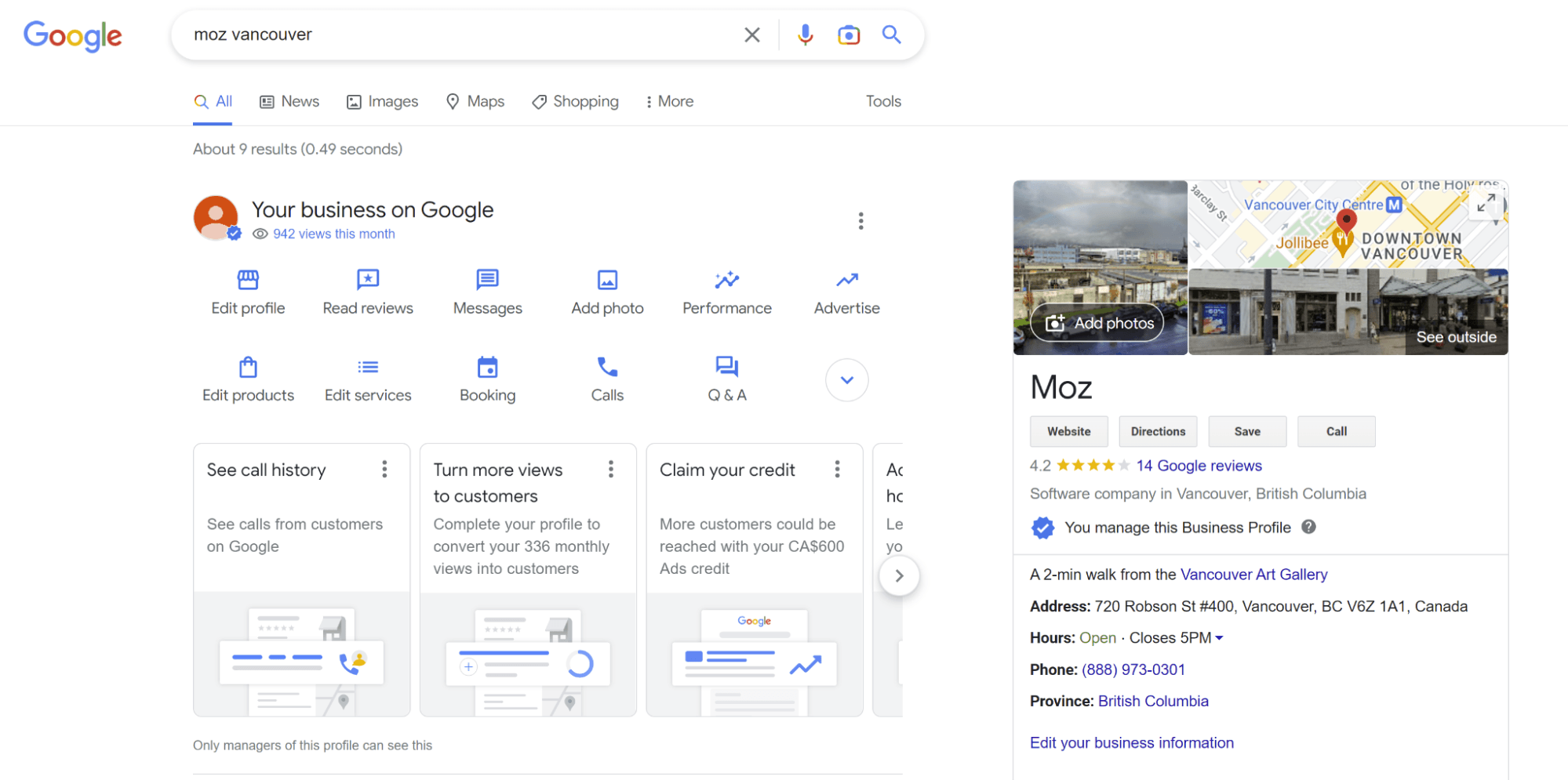
You might rightly remark that major change was the last thing you needed right now as a local business owner or marketer. But, deep down, you know you’re going to have to get the hang of this sometime, and this column is here to help you with that. After all, with estimates as high as 70% – 80% of local business leads happening right within Google’s interface, you can’t ignore GBP. Instead, you’ve got to learn to control every bit of it that you can. This article will take you through the most common features of these listings, explain what you can and can’t control on them, and teach you how to manage controllable features in the NMX.
If, after reading this cheat sheet, you find you just can’t stand the clutter of trying to manage your listings via the NMX amid the crowded organic SERPs, remember that listings management software like Moz Local still offers the niceties of a clean, organized dashboard for those who require a quieter workspace.
Core features on most Google Business Profiles and NMX interfaces
There is significant variation of Google Business Profile and NMX features based on business industry and category. For example, hotel listings have elements that aren’t included in listings for plumbers or grocery stores. Google is continually experimenting with new features while demoting others. This section will cover some of the commonest elements available to most businesses.
Before we look at our graphic and key, it will help you to know that you can access the New Merchant Experience by searching within Google’s organic SERPs for the name of your business, or the name of your business + its city, or for the phrase “my business” while logged into your Google account.

1. See Photos
When clicked on, this takes the user to both owner and user-generated photos in a set. Photos significantly impact CTR. Photos must be monitored for spam. You can also upload videos to your photos section, but try to post more than 2 videos so that you’ll get a separate mobile video subtab. It’s also important to know that previous versions of Google’s local product offered an analytical feature called “Photo Insights” but this no longer exists in the NMX.
Controllable?
Partly — photos are both an owner and crowdsourced element.
Where to control?
By clicking on the “Add Photo” link in the listing or the NMX, you will be taken to the following wizard for uploading different types of photos.

If you wish to view all your photos for the purpose of identifying user-uploaded spam, click on the image, itself, in the listing, rather than the “add photos” link, and you will be taken to the interface where you can both see and flag photos.
2. Maps
When clicked on, this takes the user to the Maps-based listing accompanied by map with pin. Be sure your map marker is correctly placed.
Controllable?
Partly — owner can correct misplaced map marker, but users can submit placement edits, too.
Where to control?
If your map pin is in the wrong place, click on the “Edit Profile” link in the new interface, then click the “Location” tab at the top of the “Business Information” pop-up, then click on the map.
3. See Outside
When clicked on, this takes the public to an interactive Google Street View visual of the business. When you are logged in, clicking on the feature takes you to this interface for uploading your own exterior imagery:
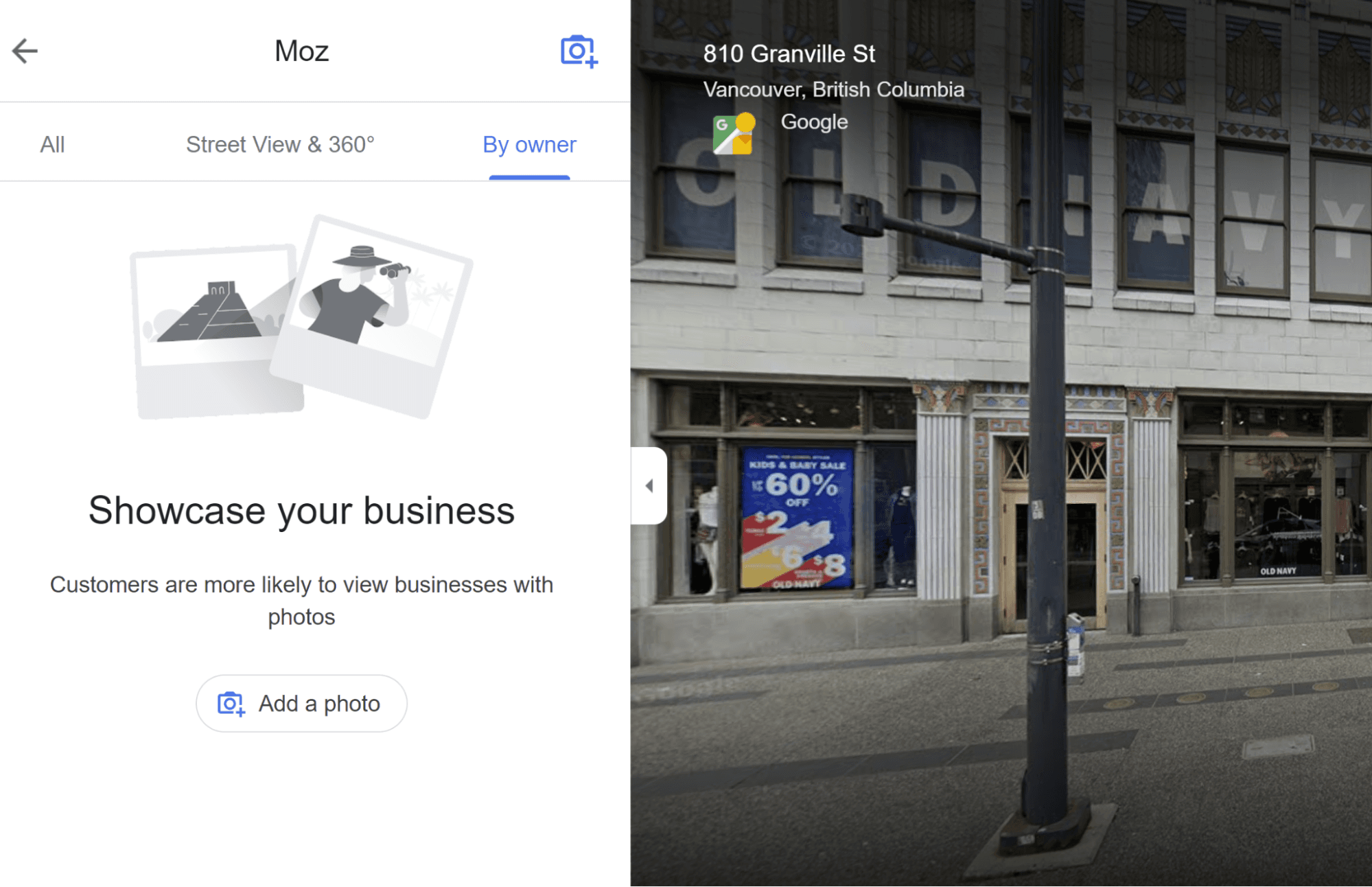
Controllable?
Partly — the owner can upload their own exterior shots, but cannot control StreetView. You can flag issues.
Where to control?
Click on the “see outside” section of the Google Business Profile to upload photos.
4. Business name
This must reflect the real-world name of the business and be formatted according to Google’s guidelines. If you’re marketing a service area business like a plumbing franchise without storefronts, your name should match what appears on your website.
Controllable?
Yes — the business owner provides, though the public can suggest edits to this feature.
Where to control?
In the NMX, click the Edit Profile link and mouse over your name in this popup to edit it in the About section:
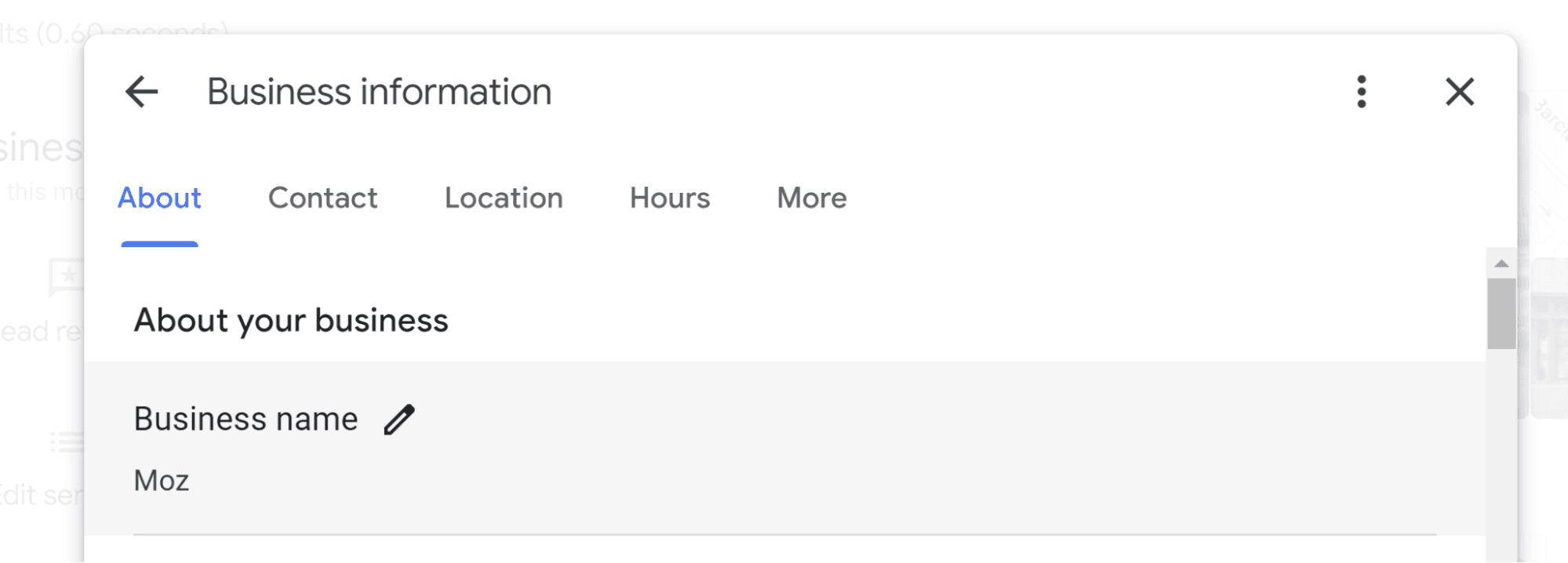
5. Website
This link takes you to whichever page of your website you’ve designated as the Google Business Profile landing page.
Controllable?
Yes — owner provides, though the public can edit.
Where to control?
In the NMX, click the Edit Profile link and mouse over your name in this popup to edit it in the Location section:
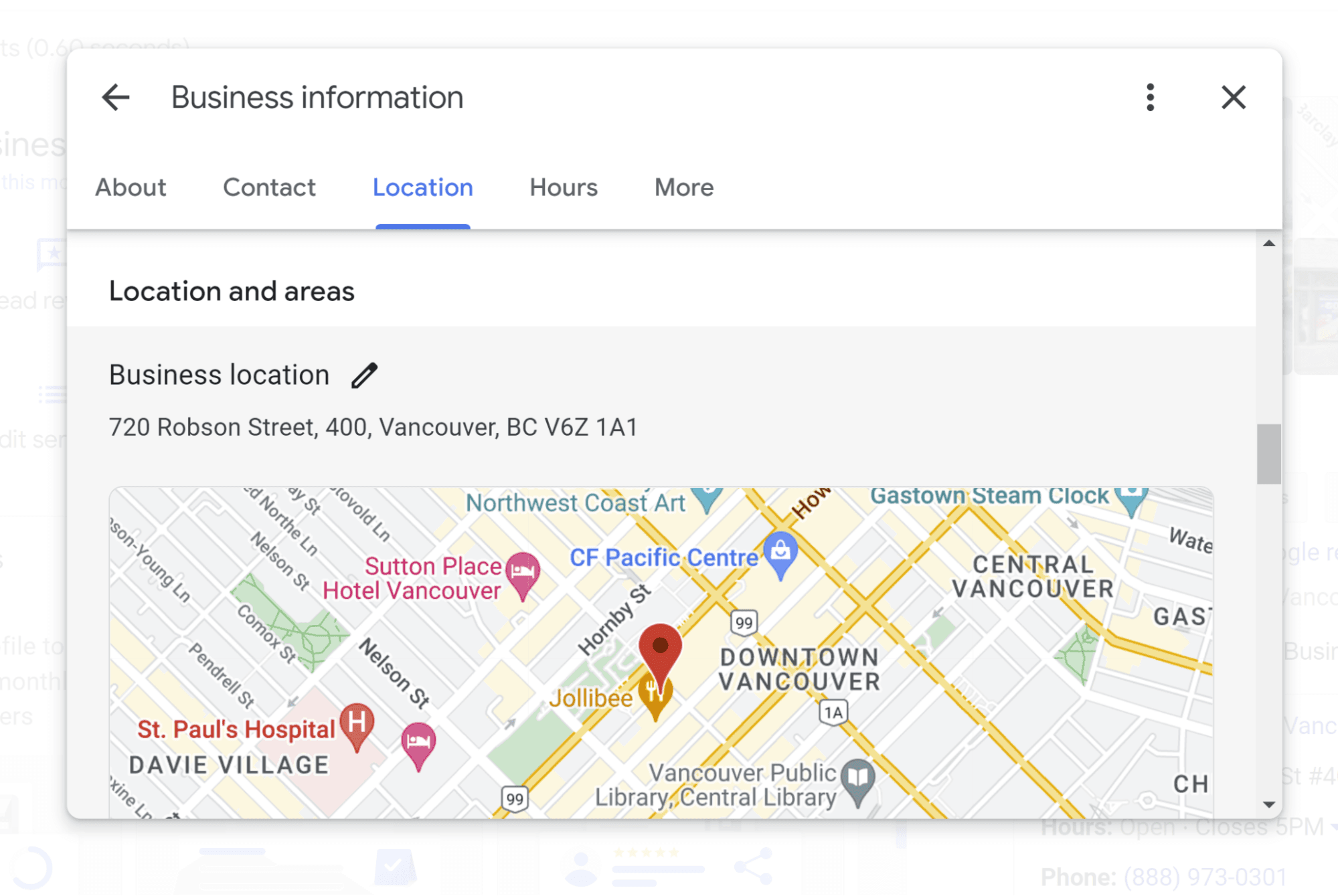
6. Directions
This link takes you to the maps-based driving directions from the user’s location to the place of business.
Controllable?
No. This experience is created by Google. However, see earlier advice if you need to move your map pin.
7. Save

When a user is logged into their Google account, clicking the “Save” button brings up the above pop-up, enabling them to store the business in their favorites or other areas like places they want to go or are planning to travel to.
Controllable?
No — Businesses do not control whether customers utilize the “Save” function.
8. Call
On mobile devices, clicking the “call” button automatically triggers a phone call to the business. On desktop, it brings up this popup asking the user to pick an app with which to start the call.
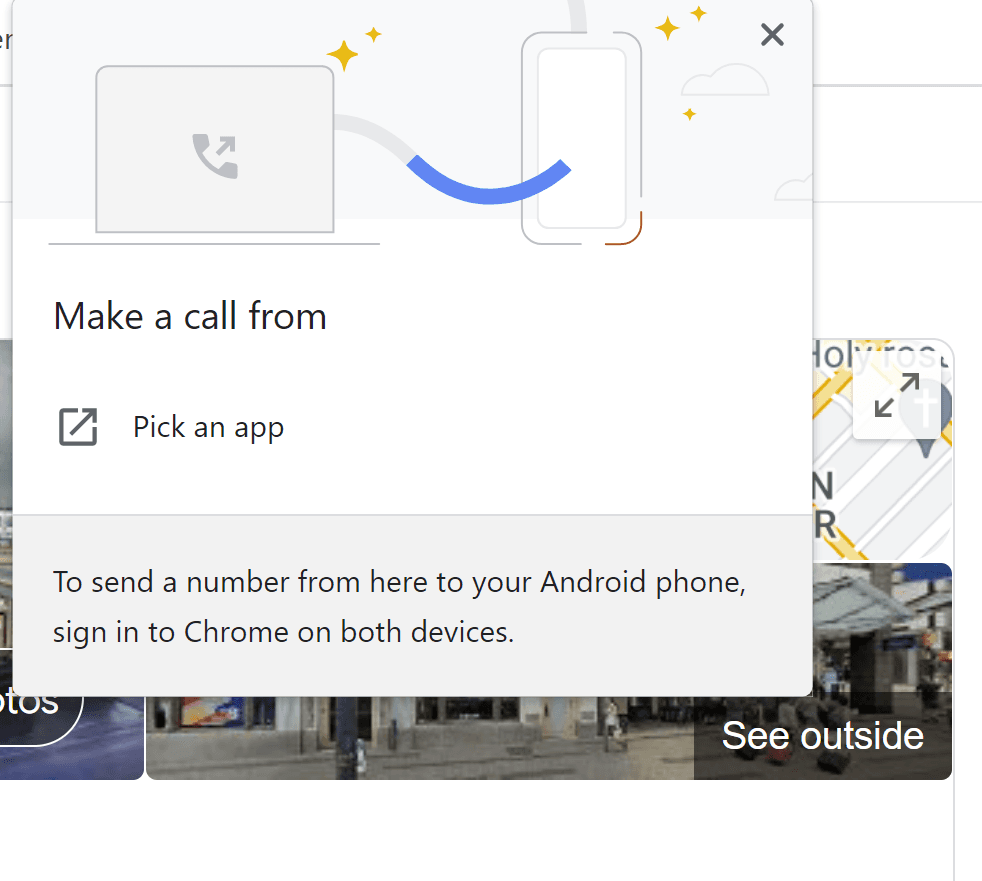
Controllable?
No — beyond ensuring that your phone number is accurate, this is not an area controlled by the business.
9. Star Rating
Google uses a simple mathematical average to calculate the overall rating of a business on the basis of all the star ratings reviewers have given the business. The star rating is considered the #1 review factor that customers use to differentiate one local business from another.
Controllable?
No — businesses cannot directly control or alter the star ratings they receive. Providing excellent customer experiences is the best way to earn the kind of reputation that results in a high Google Business Profile star rating.
10. Review Count
This is a simple count of the total number of Google-based reviews the business has received. Surveys indicate that consumers can become suspicious when any local business has either too few or too many reviews compared to its competitors. When clicked on, the review count takes the user to the main review overlay, which we will cover in full below.
Controllable?
No — the business cannot directly alter the count of its reviews, but can implement a review acquisition program to increase its total number of reviews over time.
11. Editorial Summary
This is one of the more diverse elements of the GBP. In our initial example, a common format is shown of Google taking the primary category and combining it with location information, like this, near the top of the listing:
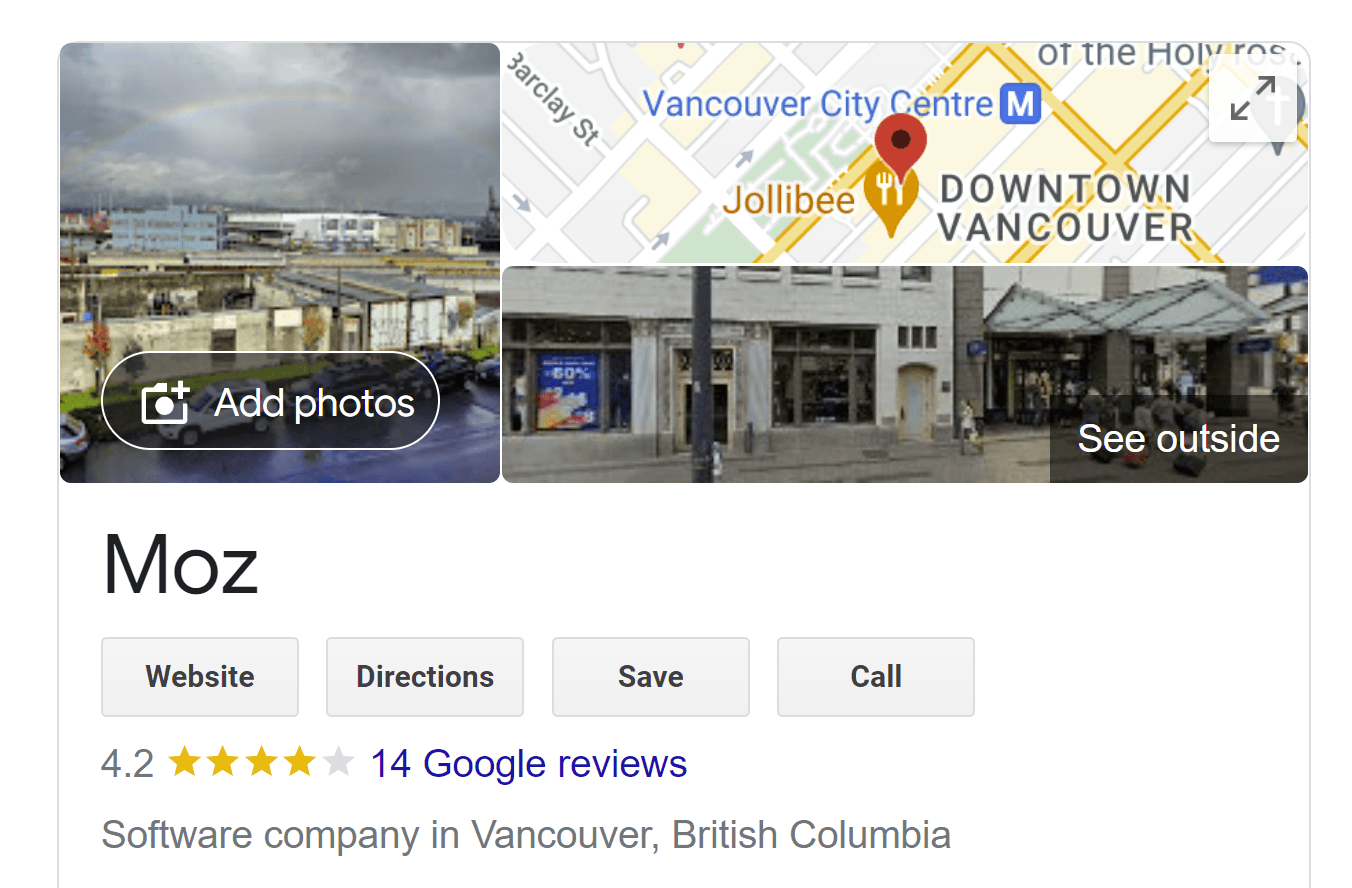
However, other iterations may also be considered editorial summaries, including this example which cites a third party like Wikipedia and may appear further down in the listing:
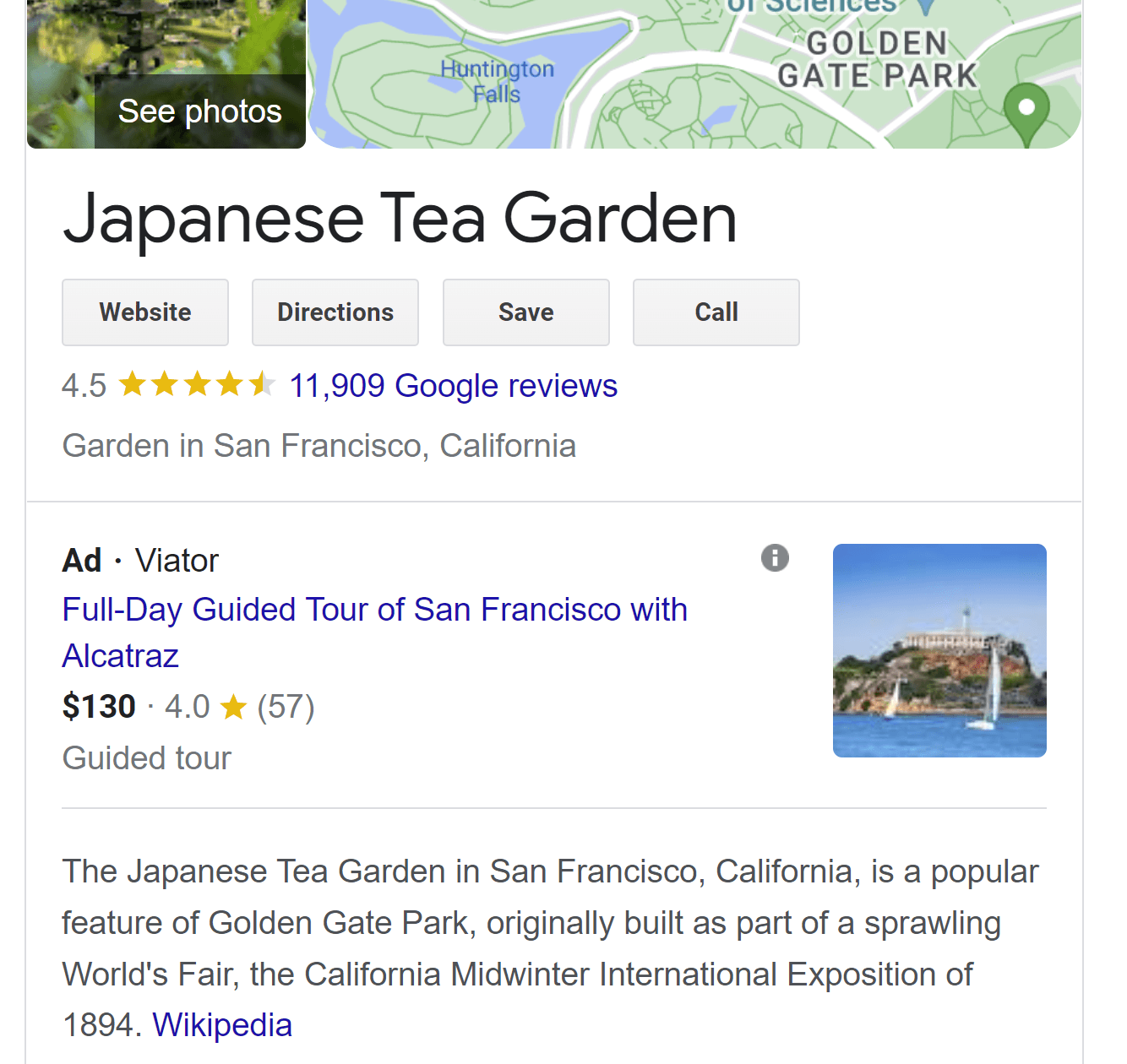
And there is at least one other version that may appear within the reviews section of the listing, specifically cite Google as the originator of the summary, like this:

The nomenclature for these elements is loose, and Google may well have unique internal names for all three instances.
Controllable?
Partly — in the case where the primary category is included in the summary along with location information, the business is contributing the information that yields that summary, and in the case of well-known entities that have control of a Wikipedia page, there would be some editorial control built into the source from which Google is deriving the description, but overall, it is Google who generates these summaries.
12. Further Directional Cues
This is a feature which only appears on some Google Business Profiles. In this example, the user is being given information about the walking distance to nearby major local attractions with embedded links to those venues.
Controllable?
No, but do be sure your map pin is correctly located so that Google can easily identify whether your business is located near to local attractions.
13. Address
For brick-and-mortar businesses, this line must display a genuine, physical address that complies with Google’s extensive guidelines. For service area businesses that don’t serve customers at the company’s premises, Google wants the address to be hidden, and instead of showing a street address, an “area served” section like this will typically be shown:

Controllable?
Yes — brick-and-mortar business owners provide their address, though the public can suggest edits to it. Google has a dedicated page of instructions regarding listing and editing addresses.
Where to control?

From the NMX, click on “Edit Profile” and then the “Location” tab to edit your address. This is also where the toggle is located to hide or display your address.
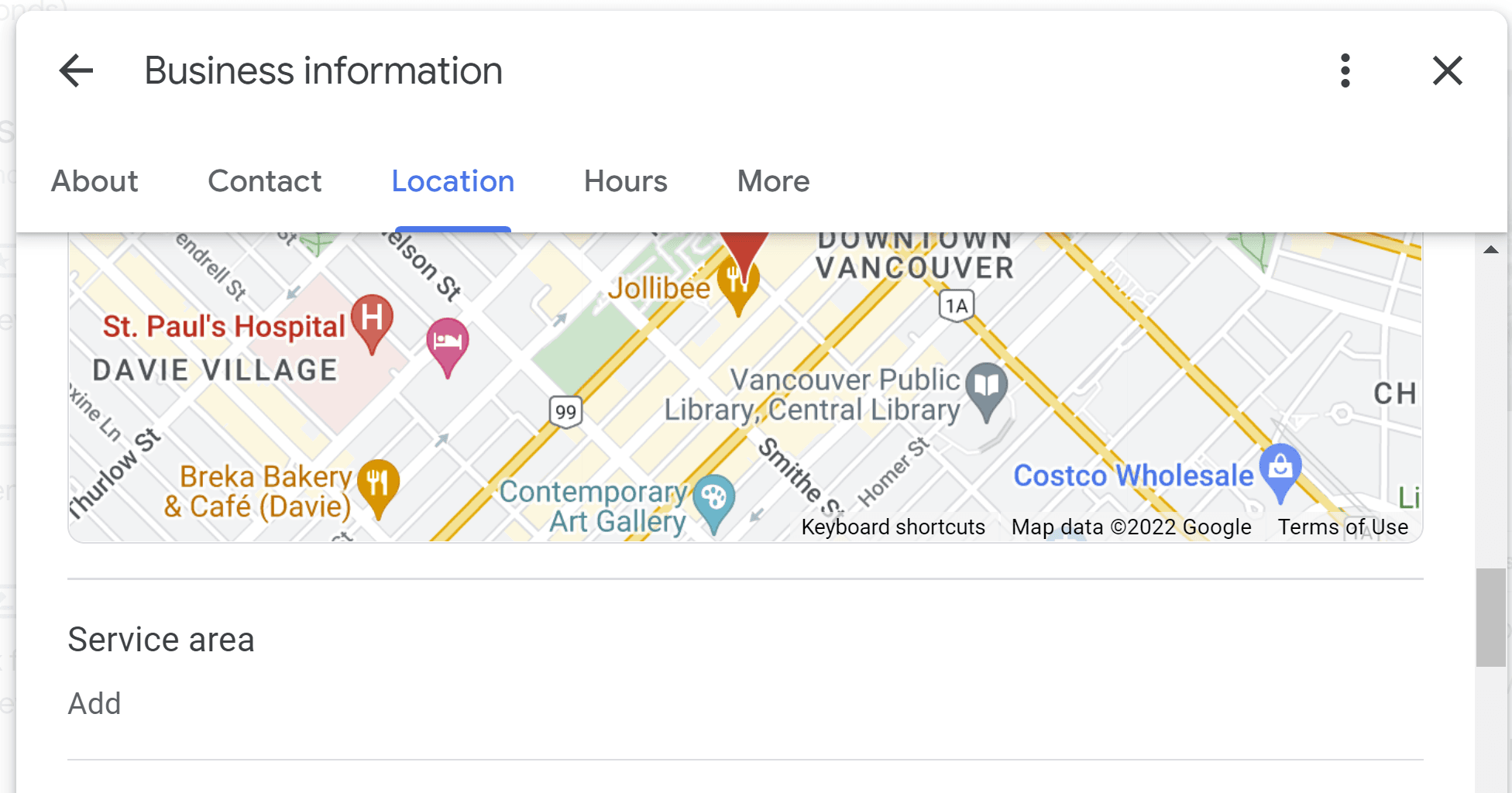
For service area businesses, the place to edit your information is also located in the “Location” tab of the NMX. You can add up to 20 locations describing your service area, but its overall boundaries shouldn’t extend beyond about 2 hours of driving time.
14. Hours of operation
One of the key ways in which Google Business Profiles provide customer service is via the presence of accurate hours of operation. Be sure yours are kept up-to-date at all times, so no customer is inconvenienced by arriving at your premises to be greeted by a “closed” sign.
Controllable?
Yes — businesses add their hours, though the public can edit them. Businesses can also set special hours for holidays.
Where to control?

From the NMX, click on “Edit Profile” and then the “hours” tab to edit your information. You will also find a feature there for adding further special hours:
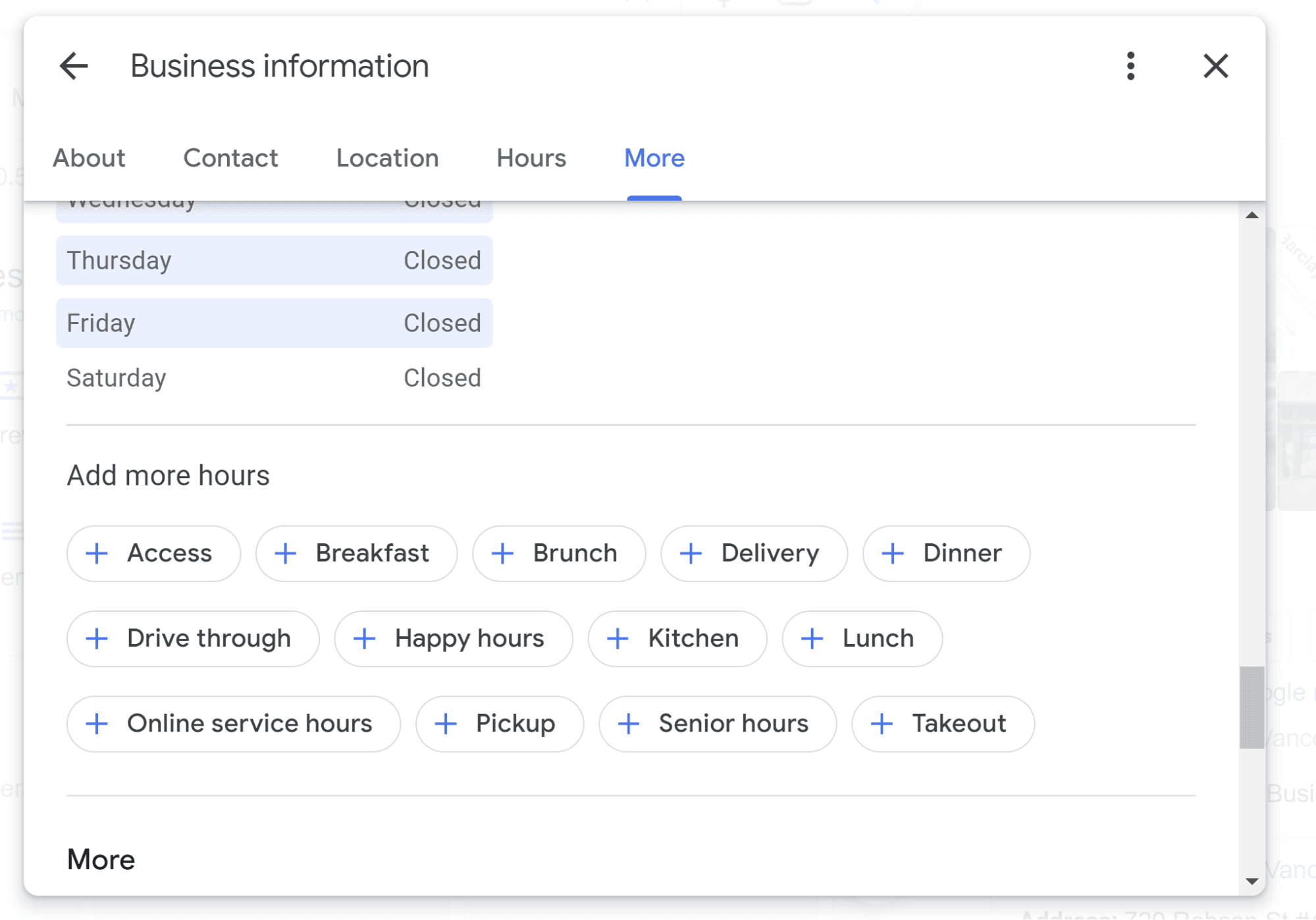
15. Phone
You can add a primary phone numbers and additional phone numbers to your listing. Google prefers that you use a local phone number rather than a call center helpline whenever possible, and they want your listed number to be in the direct control of your business. Your number can be either a landline or cell phone number, and it’s a best practice to be sure that whatever number you list is answered by staff who say the name of the business when they pick up. It’s not a good practice to have more than one business share the same phone number. For example, if you own both a Christmas tree farm and a woodworking studio on the same property and are listing each business separately, each business should have it’s own phone number. Premium-rate telephone numbers that charge callers high rates aren’t allowed.
Controllable? Yes — the business lists their numbers, but the public can suggest edits to them.
Where to control?
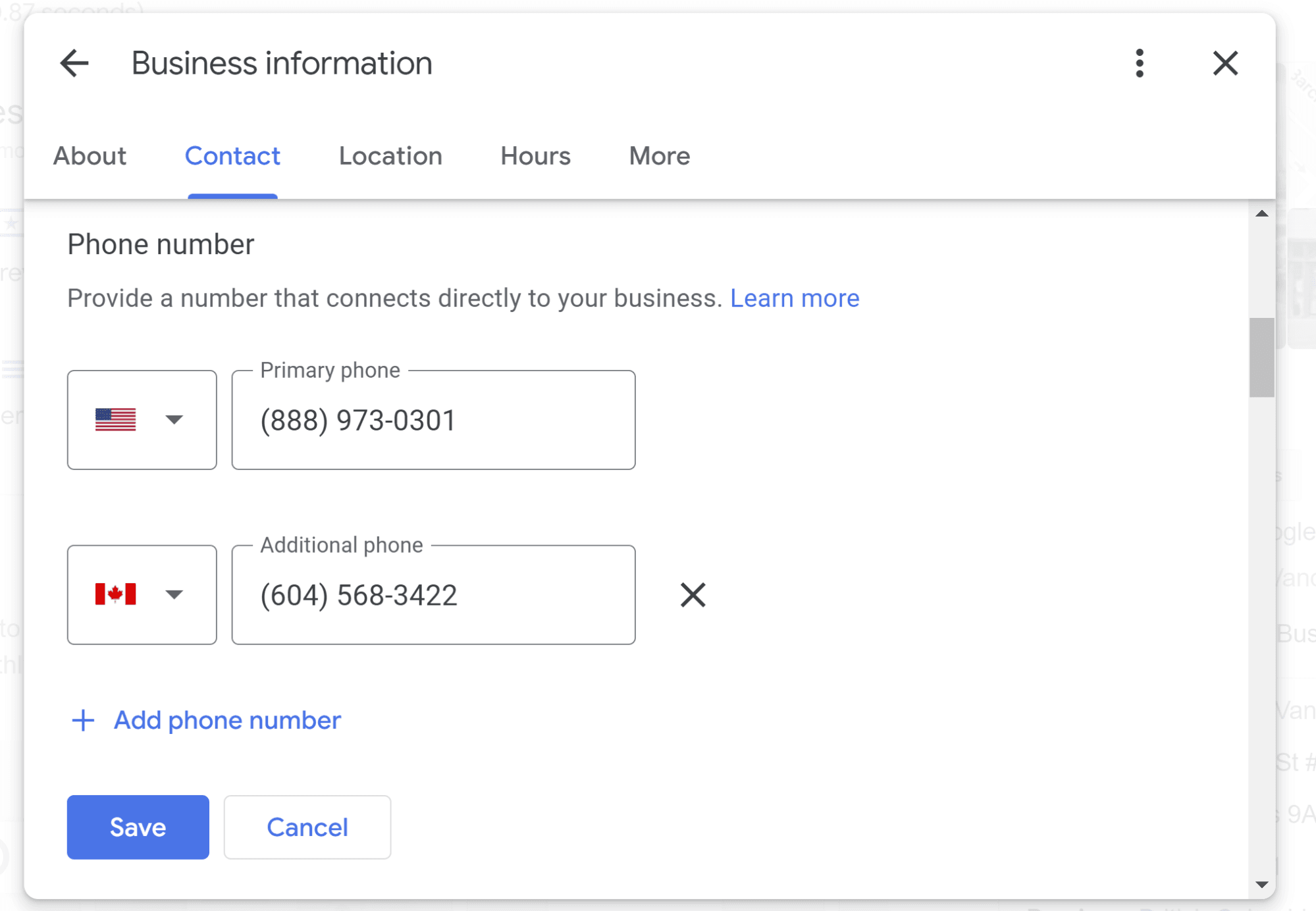
In the NMX, click “Edit Profile” and then “Contact” to see and edit your phone numbers. Related to this, the NMX also has a button labeled “Call”. When clicked on, this button will ask you if you want to enable Google’s call history feature, which you can read more about here:
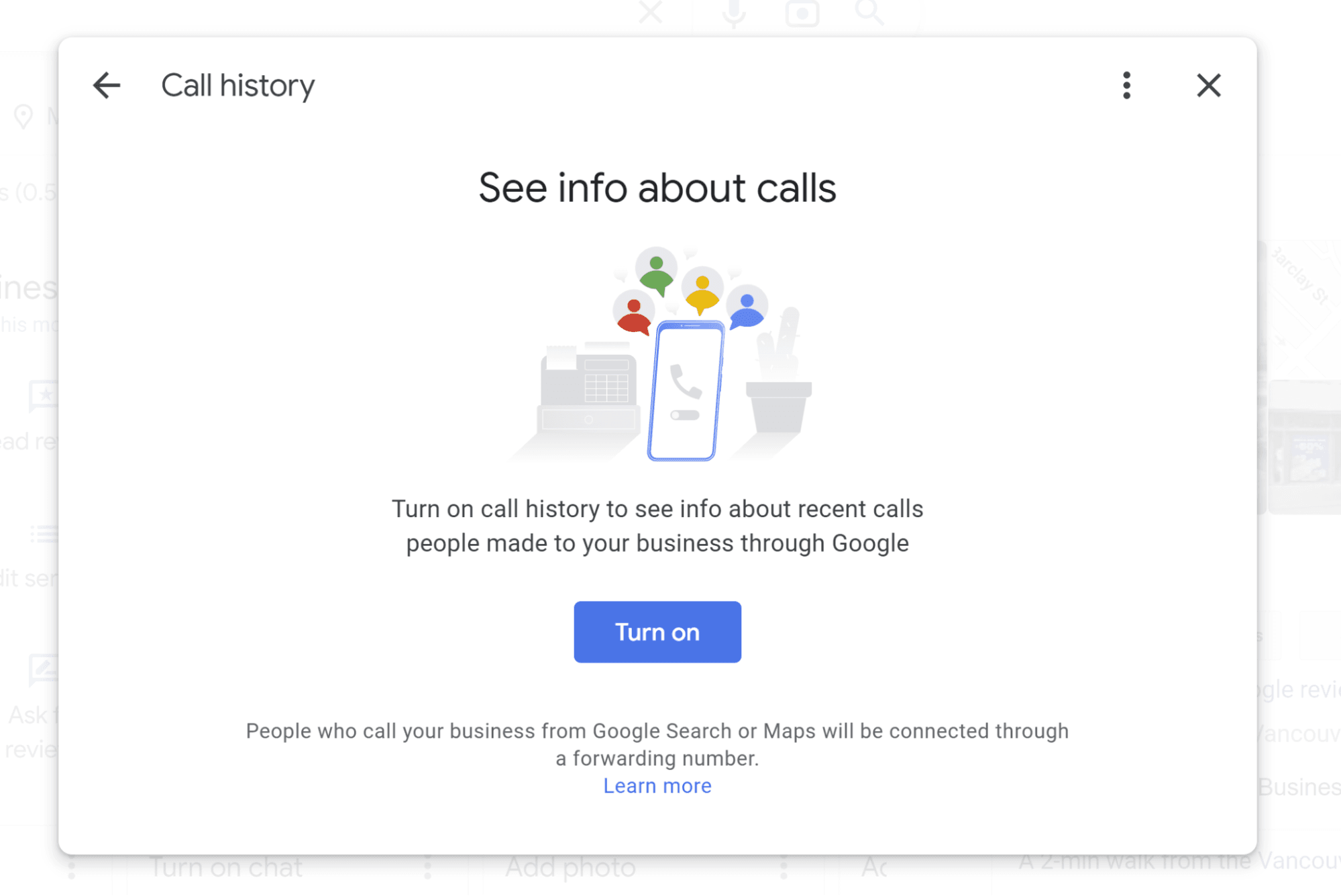
16. Further Location Information
In our example, Google is providing additional location information. Some listings will have a province or county listed in this area. Others will have a different special feature called “located in” that can appear when a business or department is contained within another entity, like the parts department inside an automotive dealership:

Controllable?
Partly — the information about your province or county relates to the physical address you provide, but the separate “located in” feature can only be edited via Google Maps. If you wish to edit this feature, find your listing on Google Maps, click the “suggest an edit” button, and look for the “located within” area of the editor:
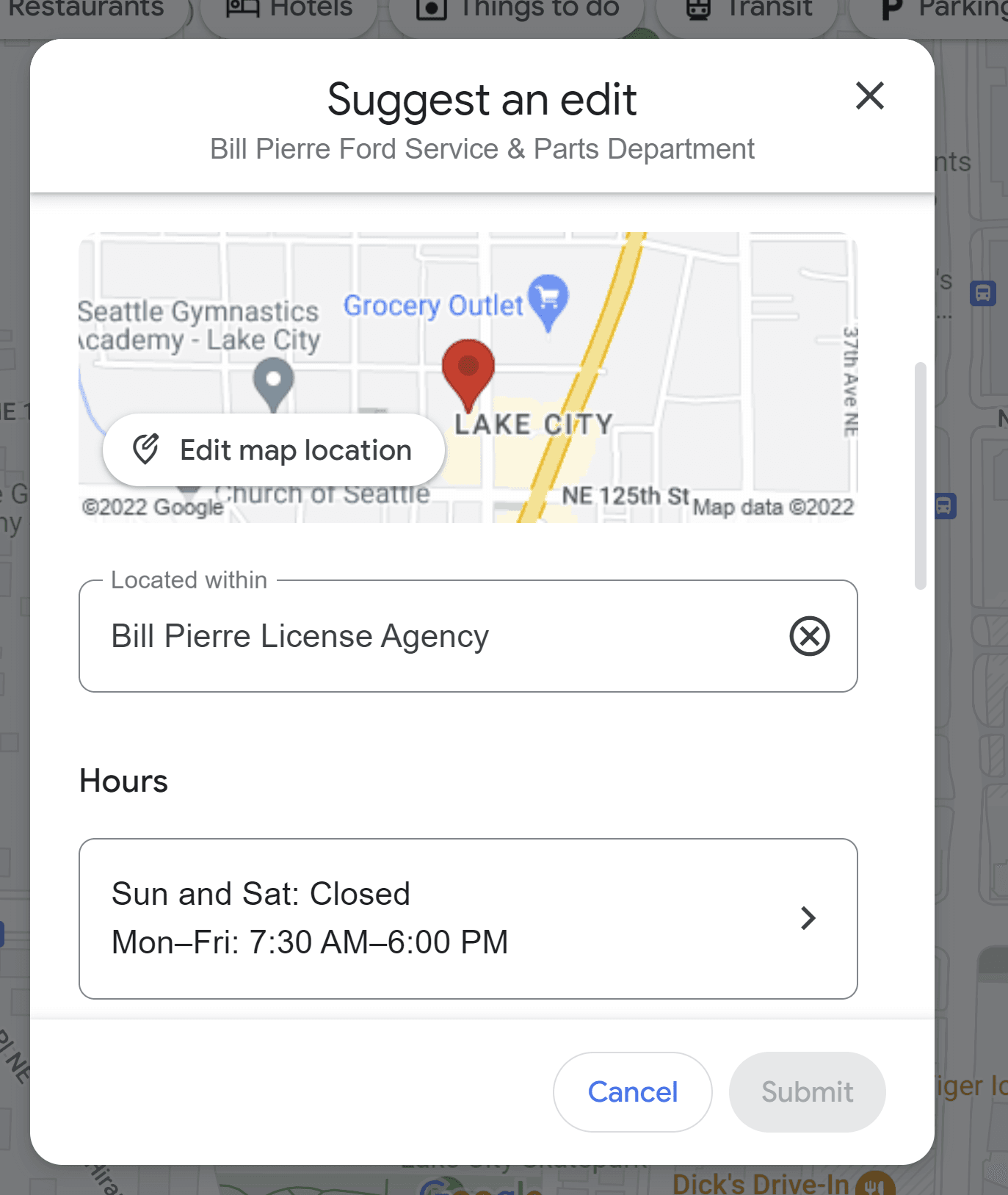
17. Suggest an edit
This function is available to any member of the public who wishes to suggest an edit to the listing. For example, an individual can let Google know they think your address, or hours of operation, or phone number is wrong.
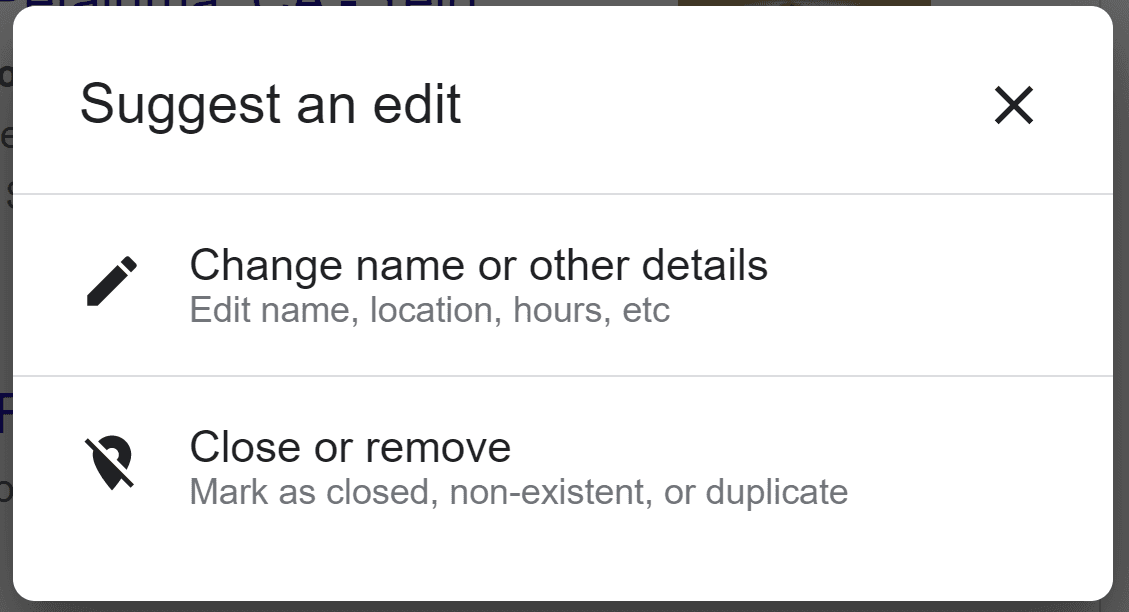
Controllable?
No. Unfortunately, the suggest an edit feature is a cause of confusion and stress for many local business owners who have no control over whether or not members of the public suggest edits to listings. The difficulty of the scenario is summed up well by this Diamond Product Expert in Google’s help forum:
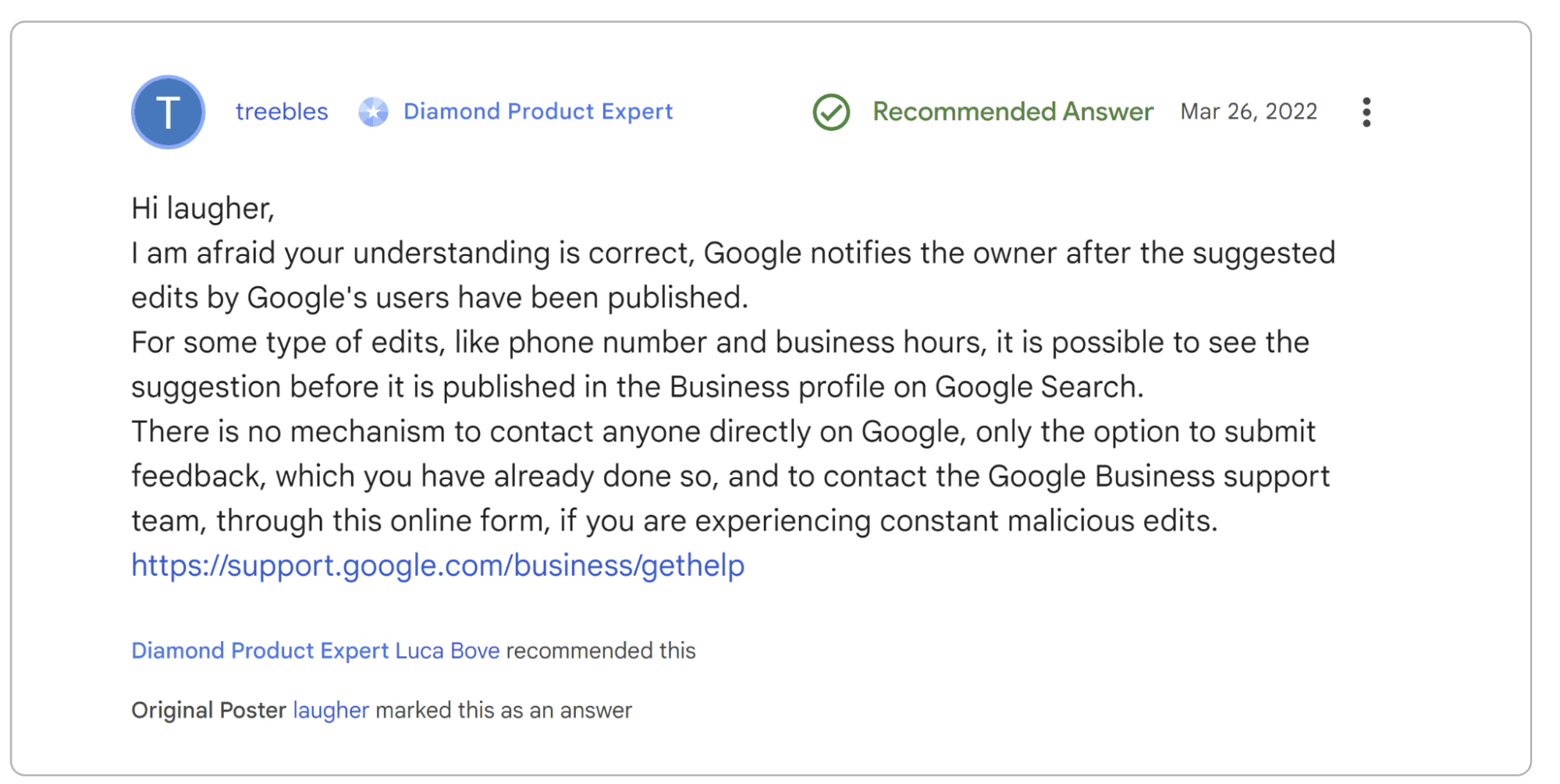
18. Own this business?
If you see this link on a listing, you either haven’t claimed the listing in question or are not logged into the account you used to claim the listing. Claiming a listing is the terminology for verifying with Google that you are authorized to take control of the management of a listing for a specific business. If, however, you are logged in properly and have already claimed the listing, you should see this link, instead:

Controllable?
Yes — you can claim listings you have the authority to represent and once you have claimed them, you can use the edit link to be taken to the NMX to edit your listing at any time.
19. Products
You can greatly enhance your listing by adding products to it representing key offerings in your inventory. These can be physical products, like retail goods, digital products, like software, or intangible products, like home services. You can add a price, description, buttons, and links for more information.
Controllable?
Yes — you can add products.
Where to control?
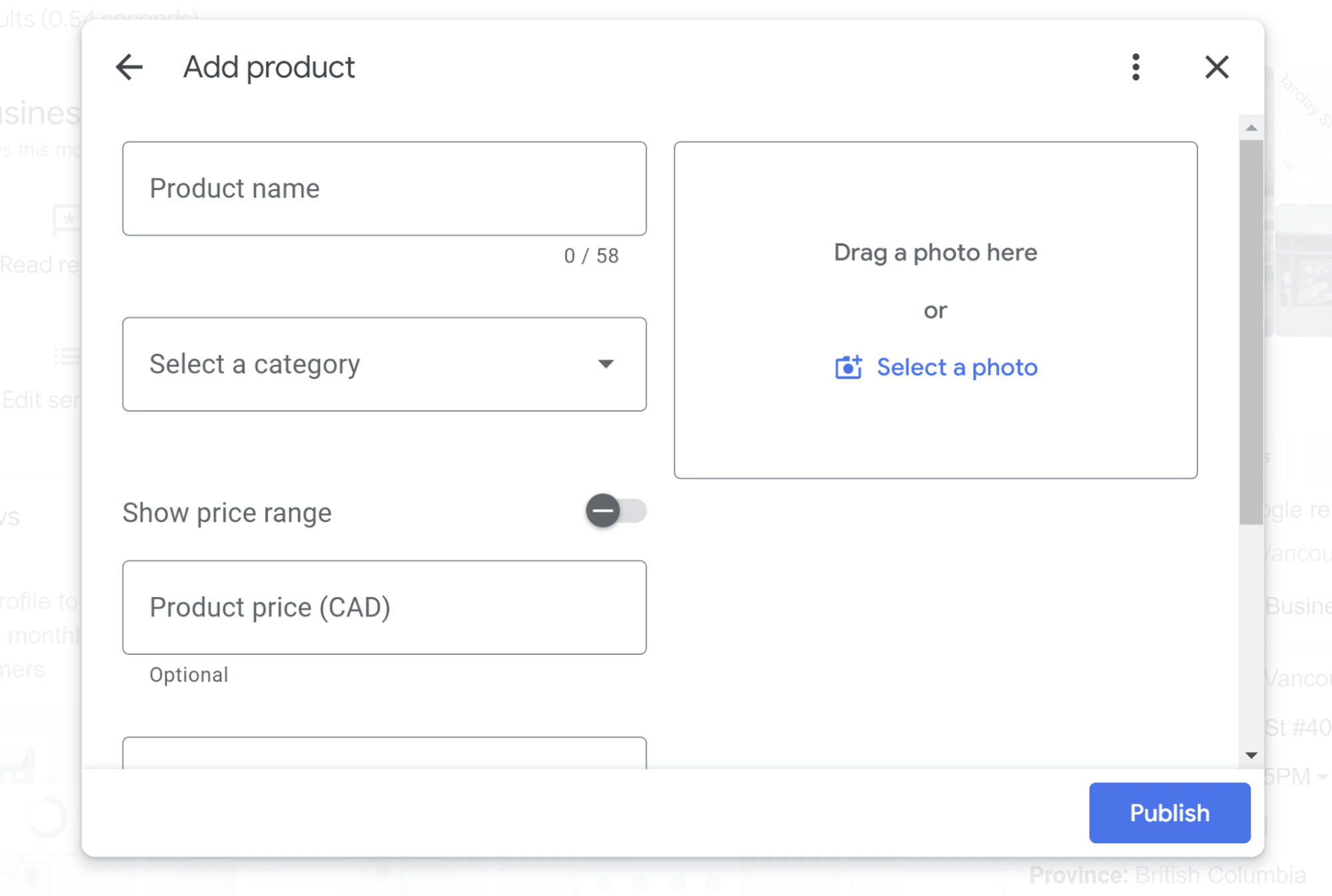
In the NMX, click “Edit Products” then click, “Add product” to be taken to the product editor.
20. Questions & Answers
Businesses are permitted to use this feature to upload questions they commonly receive and answer them. The public can also ask questions and answer the queries others have submitted. It’s important to continuously monitor this area of the GBP to be sure that questions from the public are receiving timely, authoritative answers from your brand, rather than random answers from the public which may or may not accurately reflect the business.
Controllable?
Partly — you can ask and answer questions but the public can also both ask and answer.
Where to control?

To add and answer questions, click the “Q&A” link in the NMX and you’ll be taken to this interface where you can either ask or answer questions.
21. Reviews
Reviews and owner responses are some of the key features that turn a static local business listing into an interactive two-way medium. For deep insight into the best strategies for review management, read The Impact of Local Business Reviews on Consumer Behavior | SEO Industry Report, but in brief, reviews are the main online seat of local business reputation, they influence local search rankings, and ratings, review text, and owner responses all have significant impacts on customer journeys. To avoid reputation damage and litigation, all review management practices must align with platform guidelines, like Google’s content guidelines, as well as the laws, like FTC guidelines, governing your country.
Controllable?
Partly — you can request reviews and respond to reviews, but you cannot control whether customers leave you reviews and you are not permitted to review your own business or incentives others to do so. Fraudulent reviews can be reported to Google in hopes of removal.
Where to control?
The NMX has several different menu items related to reviews, including “read reviews” and “ask for reviews”. Clicking on the former will take you to the entire review overlay, with “reply” functionality so that you can respond to each review or rating you receive:

Clicking on the latter will take you to a popup that generates a handy link to your review profile, with prompts to share that link via vehicles like email, WhatsApp or Facebook:
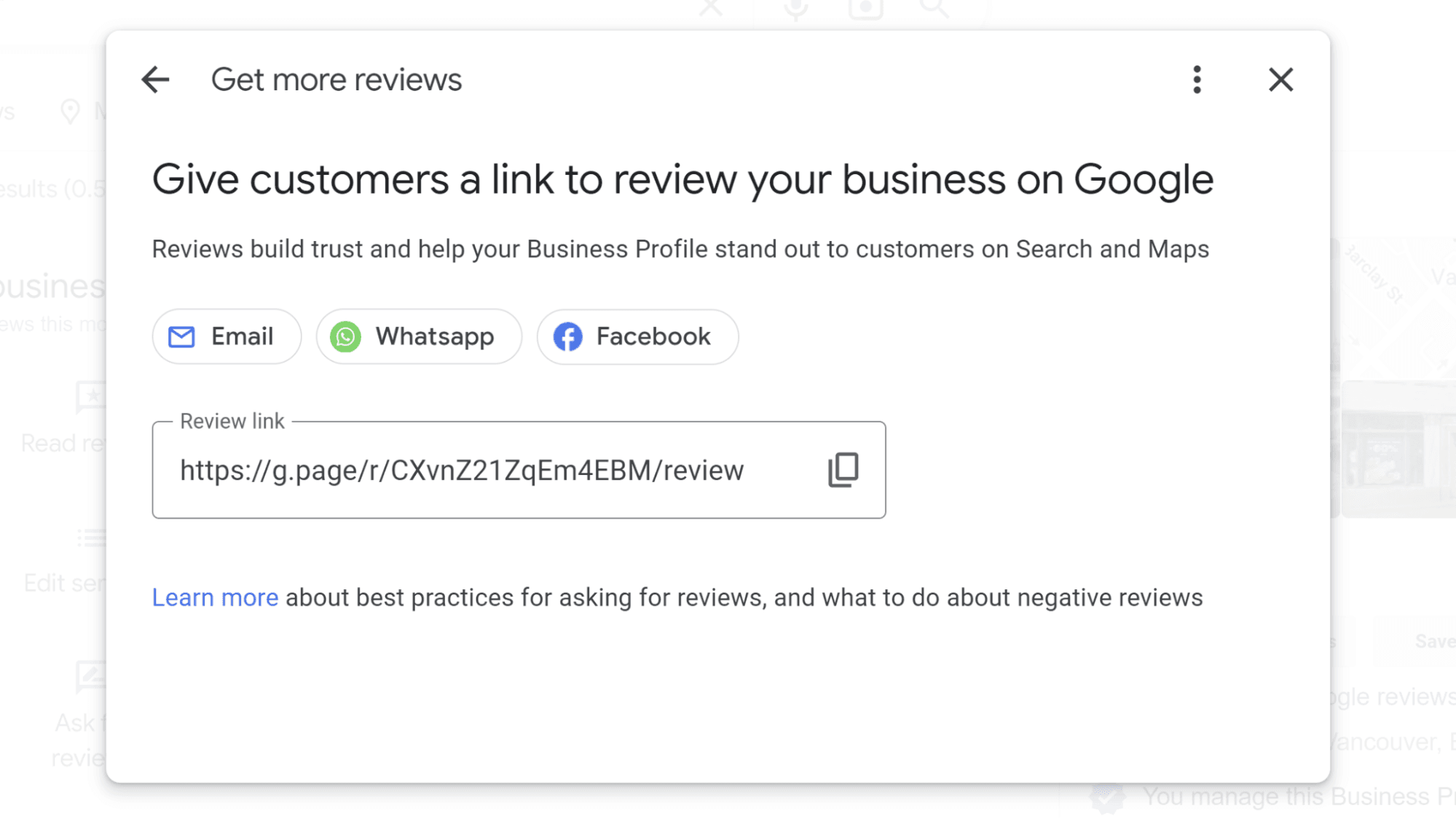
22. Updates (formerly known as Google Posts)
This feature is like a microblogging function located directly within your Google Business profile. It enables you to post new content to your listing on a regular business.
Controllable?
Yes, most business types (with some exceptions) can write updates.
Where to control?
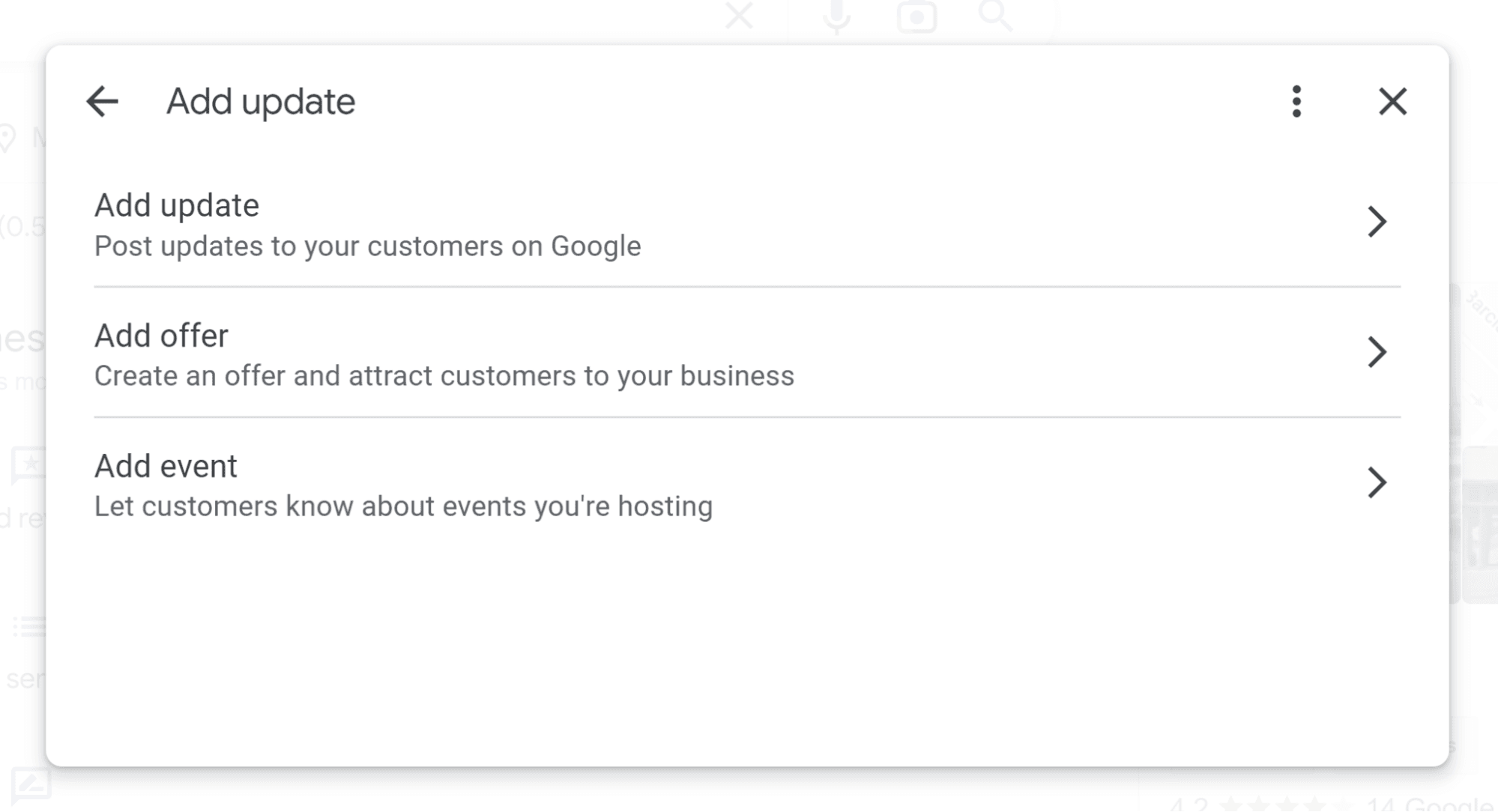
Click the “add update” link in the NMX and you’ll be shown three types of posts you can write: updates, offers, and events. The first lets you add an image, a description, and a linked button and will stay live for six months before being archived. The second includes all these fields, plus a date range setting for the period in which your offer is live, and additional informational fields to further explain the terms of your offer. The third type includes fields for information like when your event starts and ends. Some listings may also feature discontinued post types.
23. People Also Search For
This is one of those areas that makes it clear that local business rent space from Google rather than owning it. Chances are, if you owned your Google Business Profile, you wouldn’t feature your competitors on it, but this is just what Google does.
Controllable?
No — you have no control over which competitors Google shows in this section of your listing.
Additional GBP and NMX Features
Some business categories have unique Google Business Profile features or elements we haven’t yet covered. The New Merchant Experience also includes some other functions we’ve yet to explore. Let’s dive back in!
Categories
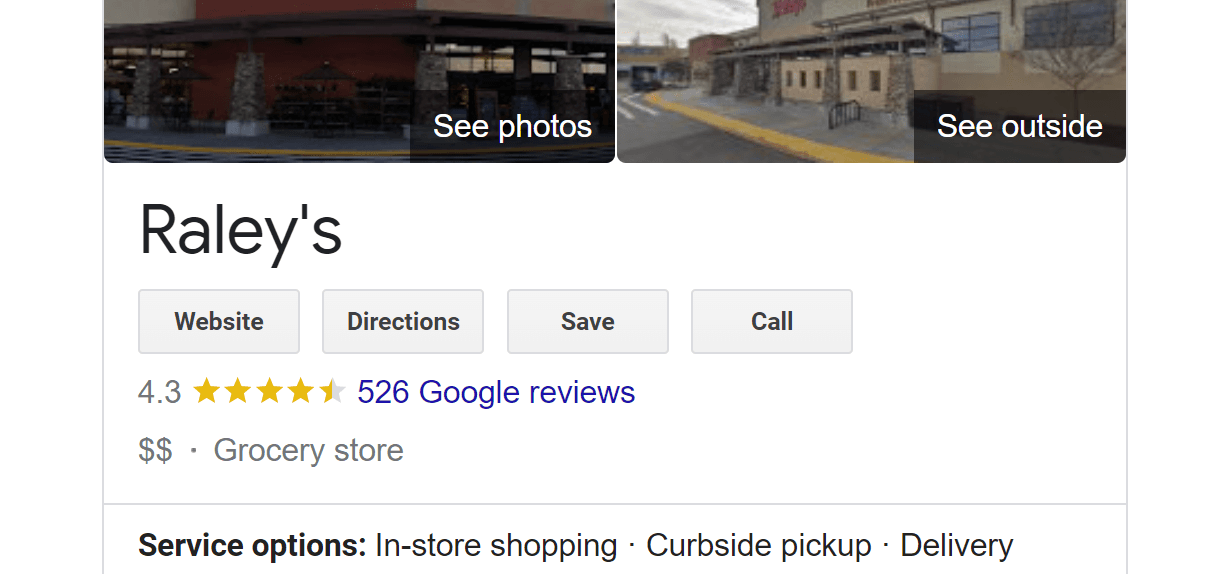
Categories may be the most important feature that you control when it comes to the search phrases you want to rank for, and categories also determine many of the fields you’ll have in your Google Business profile. Your primary category may appear on its own near the top of your GBP, but it also may appear as part of your editorial summary. In order to see all of your categories live, you have to head over to Google Maps. There, by using a Chrome extension like GMBSpy, you can see all the categories both you and your competitors are using.
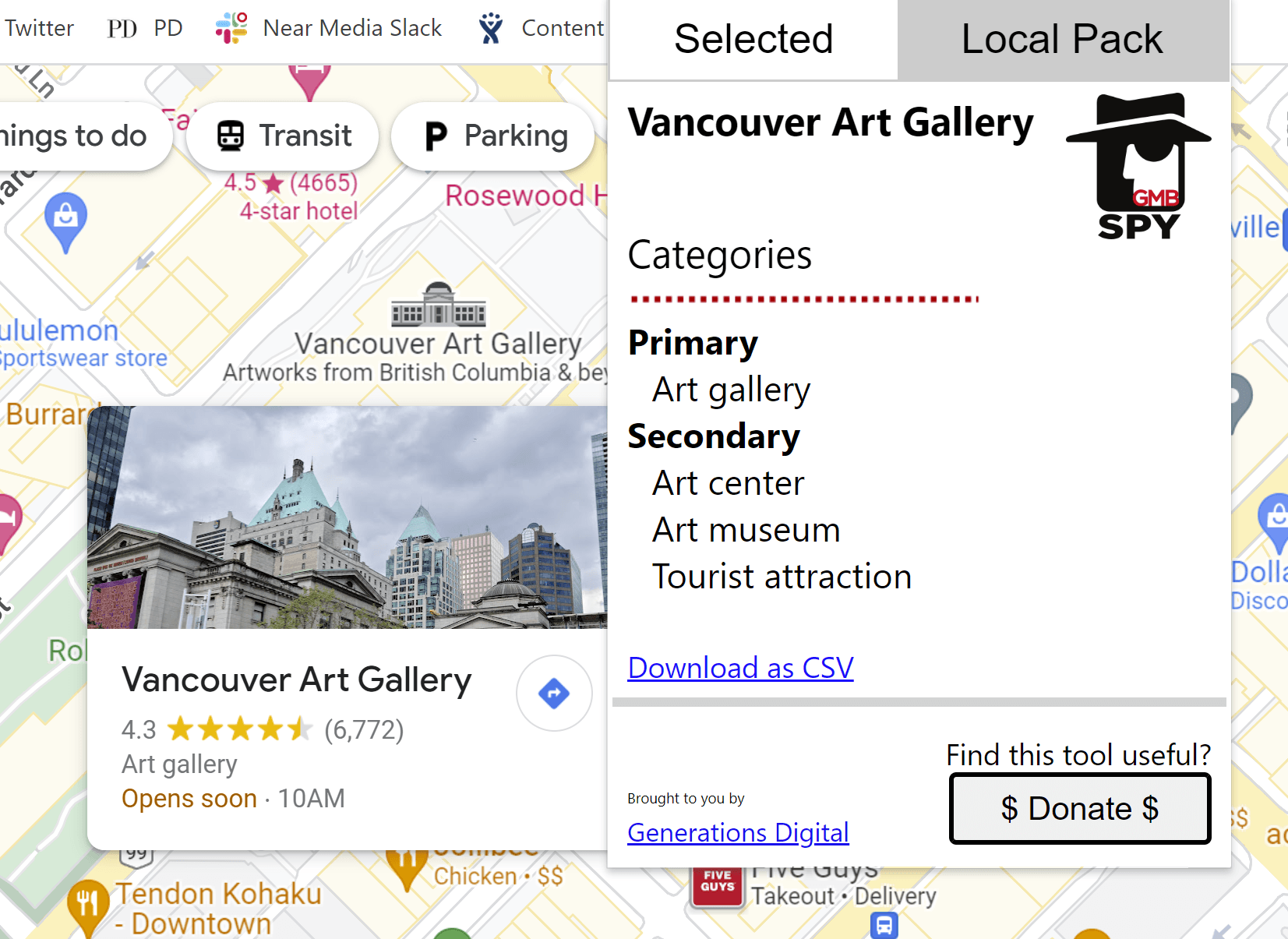
Controllable? Yes — businesses can choose primary and secondary categories.
Where to control? Click on “Edit Profile” in the NMX and edit your categories under the “About” tab.
Attributes
This is an experimental area of GBPs to which Google is always adding so that both businesses and the public can further define the characteristics of the business. Attributes can include information about who owns the business, or amenities, such as whether a building has gender-neutral restrooms, or protocols, such as whether an appointment is required to visit a business, or layout information, such as the presence of wheelchair-accessible entrances.
Controllable? Partly — businesses can add a great many attributes by clicking the “Business Information” tab in the NMX and then going to the “More” section. However, Google also crowdsources attributes from the public.
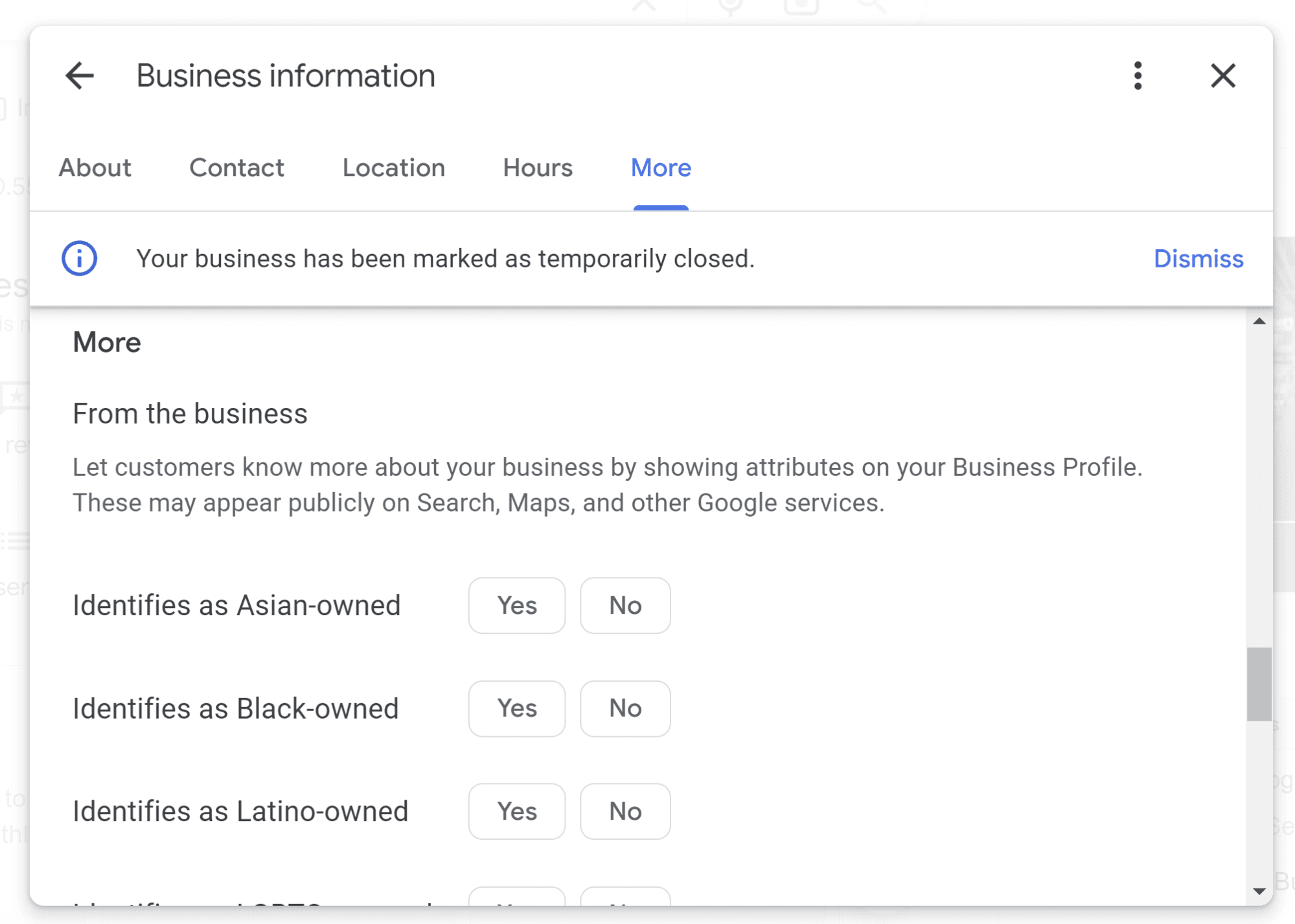
Description
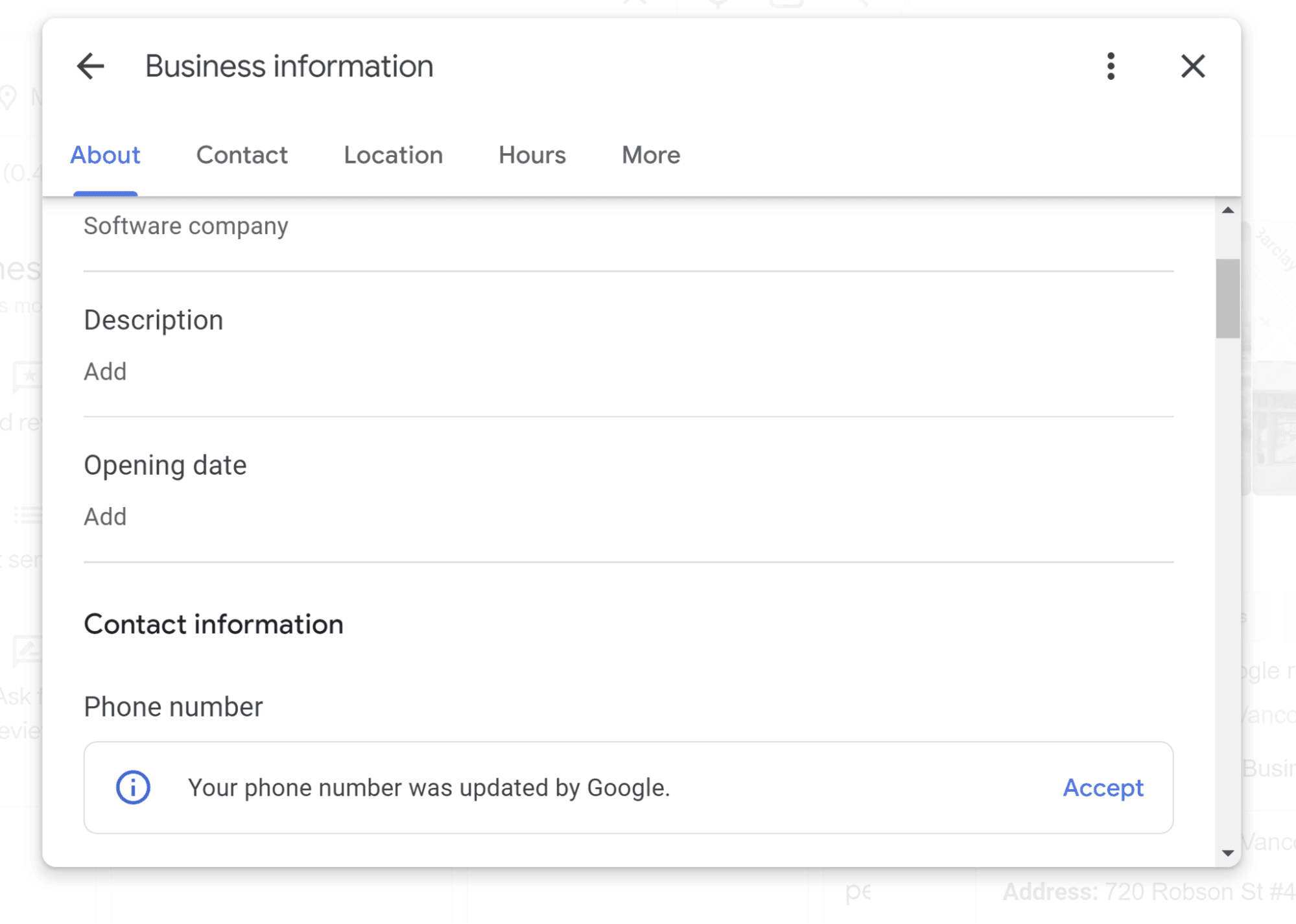
Local businesses can write a 750 character description of themselves.
Price Summary

Some business listings display a pricing overview of 1-4 dollar signs.
Controllable?

Controllable?
Unknown – Google asks reviewers to evaluate the prices they’ve paid at businesses, as seen above. There has been past debate over whether the prices published by local businesses on their digital menus influence these attributes, but Diamond Product Expert Ben Fisher has confirmed with Google that these elements stem entirely from UGC.
Menu links

Google offers a variety of menu options for businesses. Food and drink businesses have a standard menu that can link to a page on their website or a third-party platform, and menus can be created within Google itself, including menus with photos added to them. Additionally, some businesses can create service menus in Google.
Controllable?
Yes — where relevant, businesses can create or link to menus of goods and services.
Where to control?

With thanks to Damian Rollison, logged in owners of food and drink establishments should see edit menu links in the NMX, as shown above.
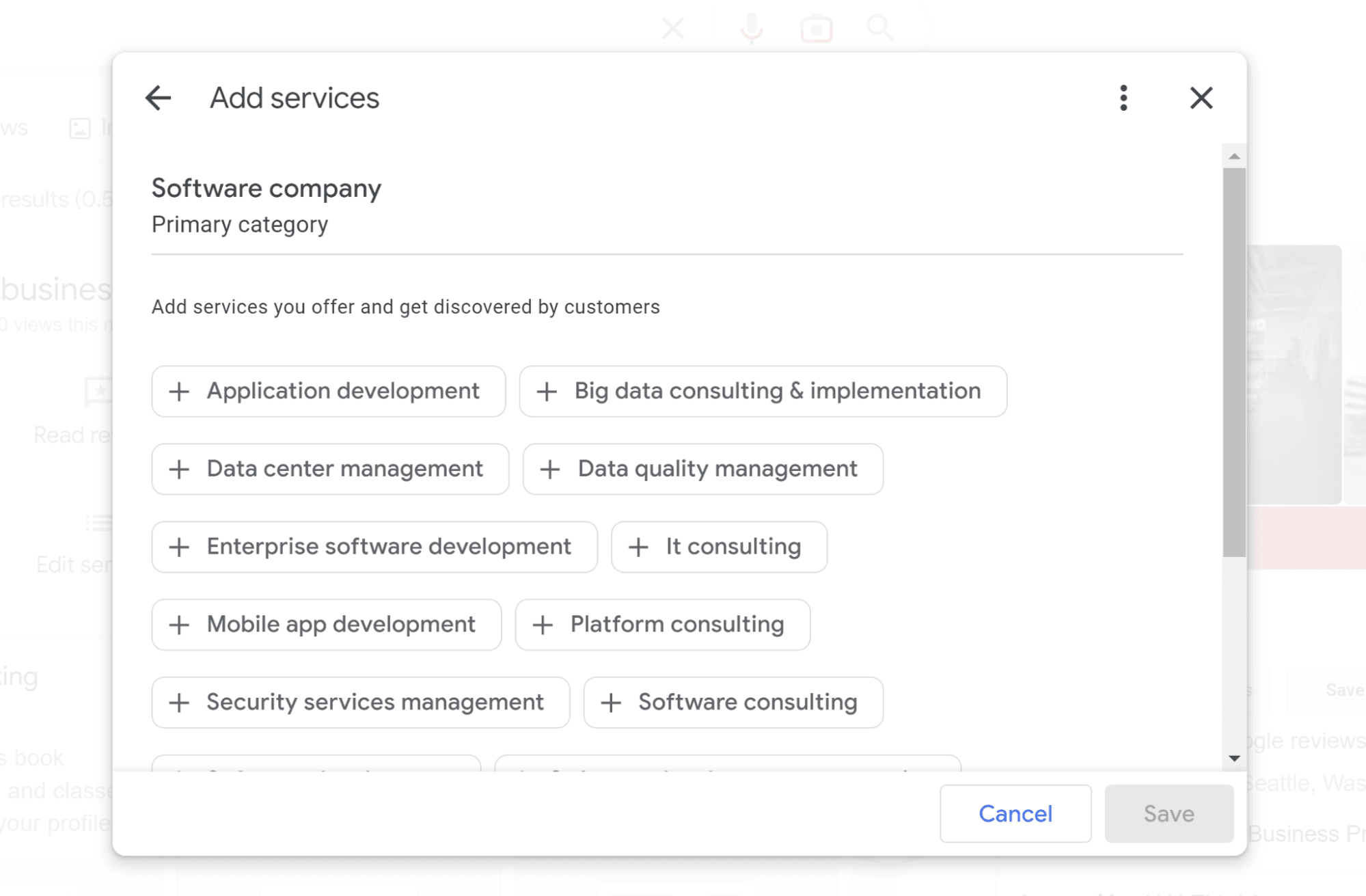
Businesses offering a menu of services can edit them under the “Edit Services” link in the NMX, including adding custom services.
Booking
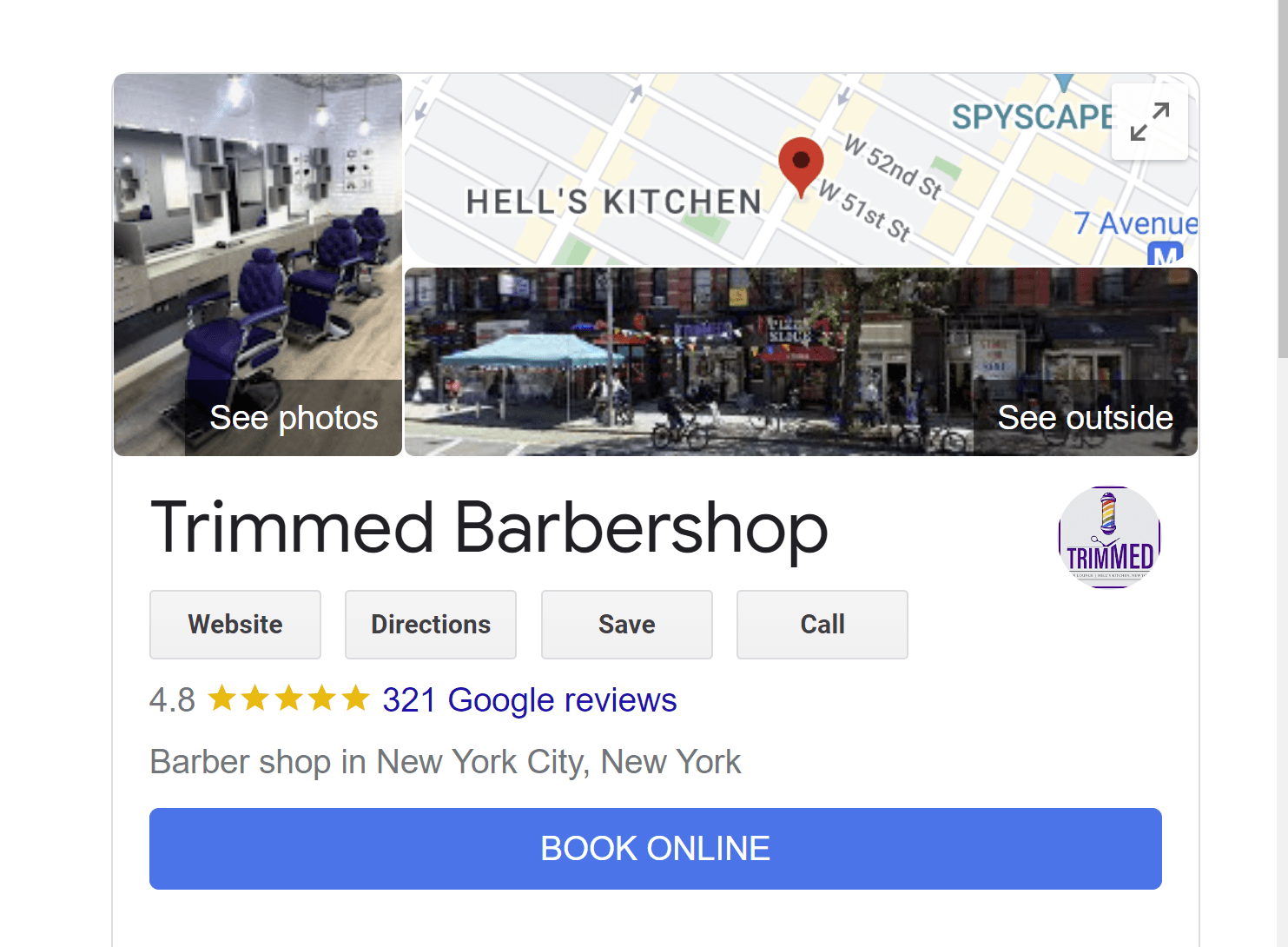
Businesses can feature several different booking and appointment functions on their listings, powered by a provider. For example, this instance on the listing of a dental practice stems from ZocDoc:
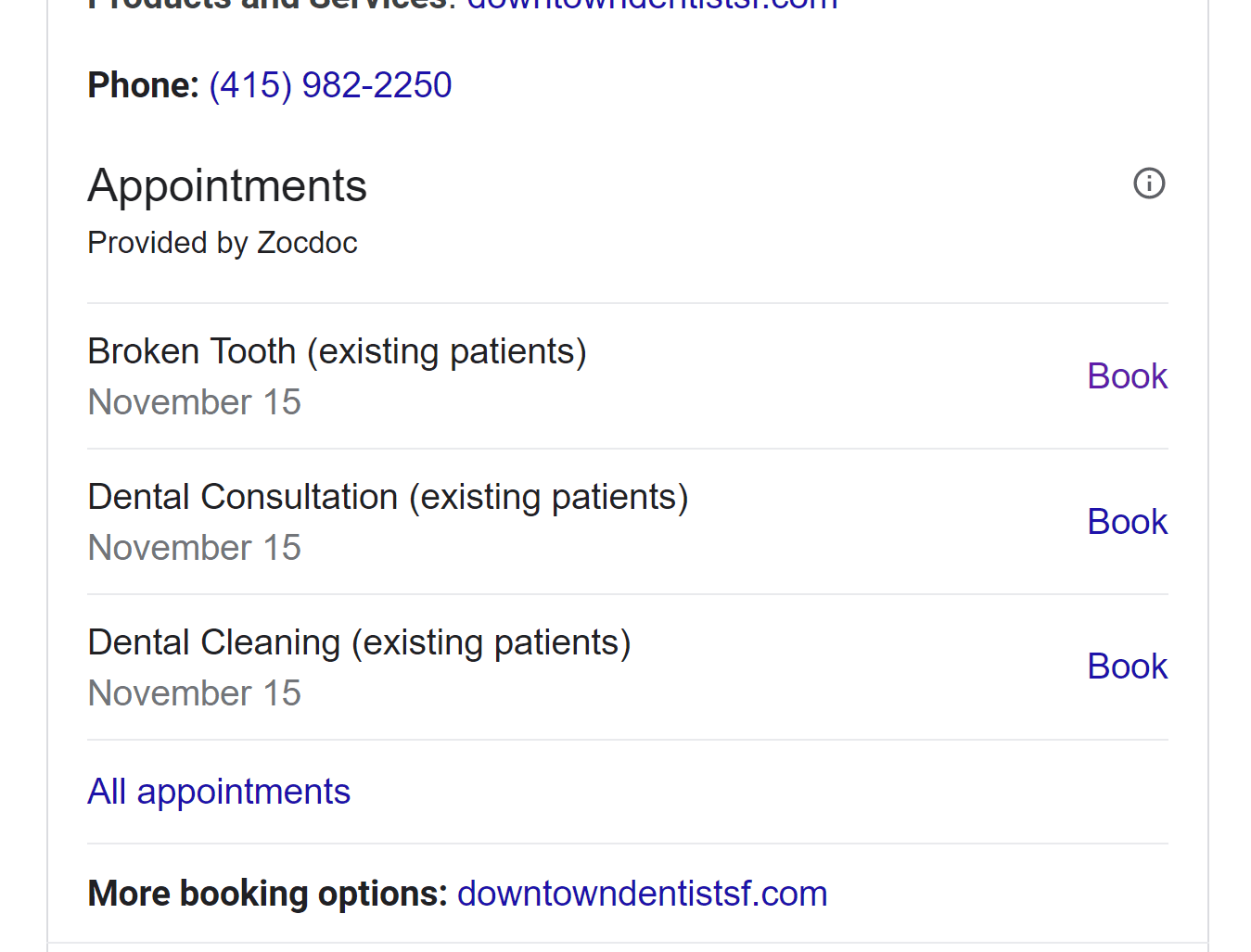
Controllable? Yes, relevant businesses can add booking and appointment features.
Where to control?
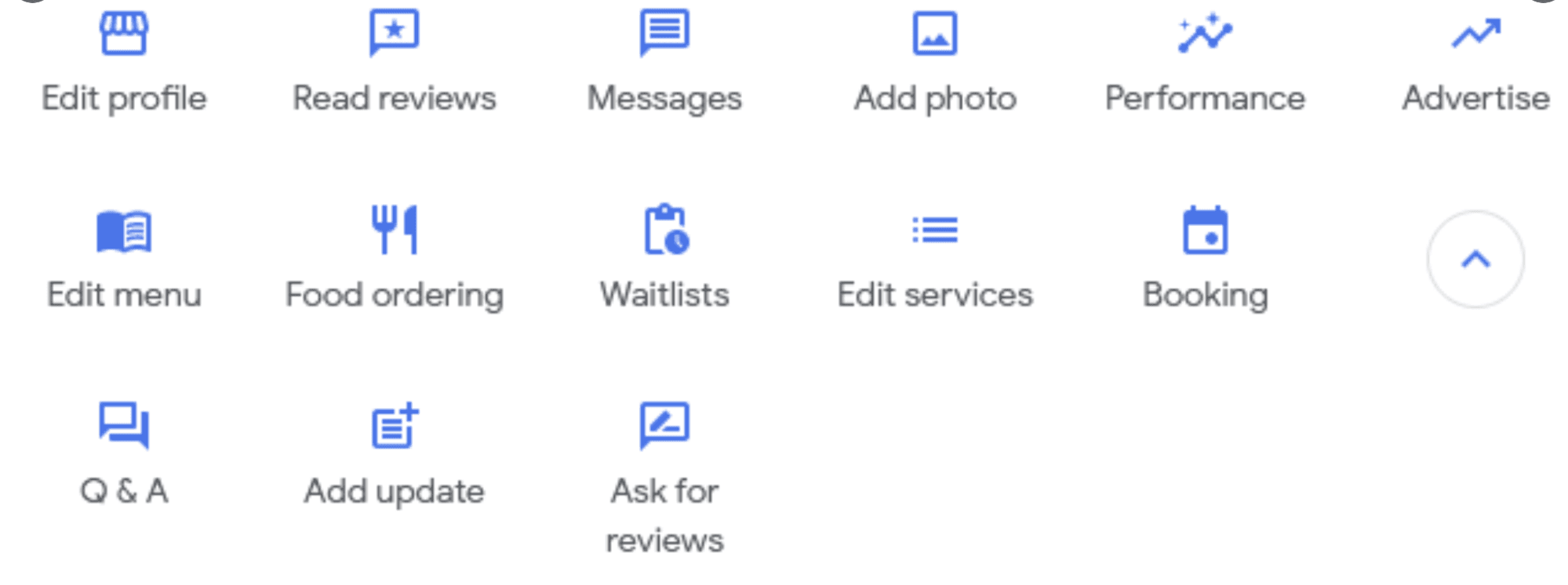
With thanks to Petra Kraft for the screenshot, applicable businesses should see a booking button in the NMX, as shown above. Businesses wishing to enable booking and appointment features must follow these instructions and can learn more about the Reserve With Google system here. Also pictured here is the “Waitlists” function tied to the Reserve with Google program for managing queues of potential diners.
See what’s in store

The See What’s In Store feature shows up on the Google Business Profiles of companies that have integrated the Pointy device into their point of sales system.
Controllable? Yes, if you are in the US, UK, CA, IE, or AU, have an appropriate point of sales system, and vend items with standard barcodes, you can apply to become part of this program.
Where to control? Google’s documentation states that, depending on how you signed up to be part of their See What’s in Store program, you will either be managing your inventory directly via Pointy or within your Google Business Profile.
Order online
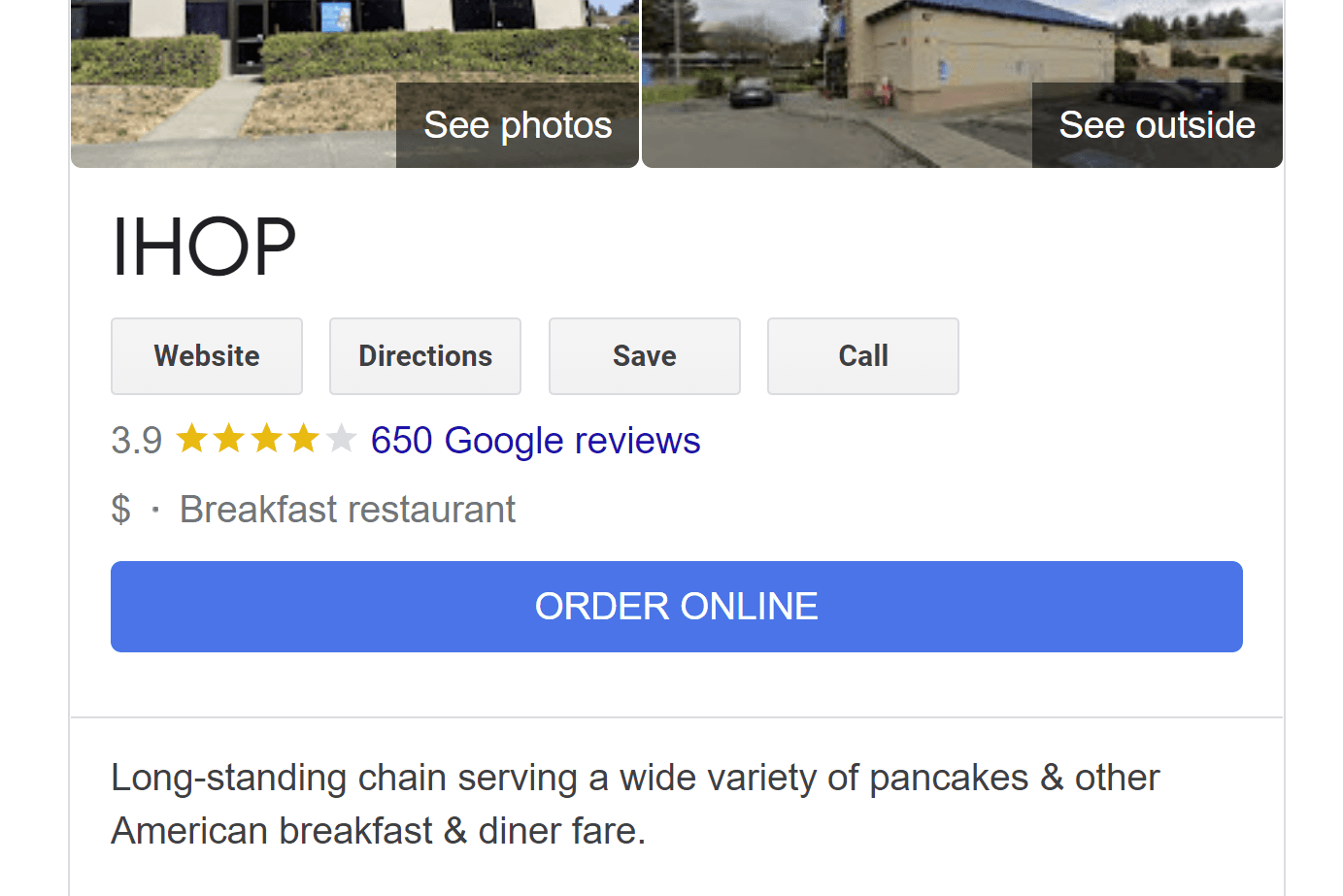
Some GBPs may feature an order online button . When clicked on, it brings up a list comprised of the brand as well as third-party services that facilitate taking digital payments in exchange for goods that can then be picked up or delivered.

Controllable? Partly — business owners can opt into this, but there has been considerable controversy over the years about whether third-party providers in the delivery business are more of a bane or blessing to local brands, and whether or not its right for Google to promote these types of services on GBPs.
Reviews from the web

This features a rating summary and links to relevant third-party review sources, determined by Google.
Controllable?
Partly — owners can’t dictate which 3rd parties Google chooses, but they can work to build up positive reviews on featured sources.
Profiles

Google business profiles can feature icon-based links to major social media sites where the company has established a presence.
Controllable? No — there is no field in the NMX for adding your social media profiles, but best practice advice is to be sure they are featured on your website so that Google can easily associate them with the business.
Popular times
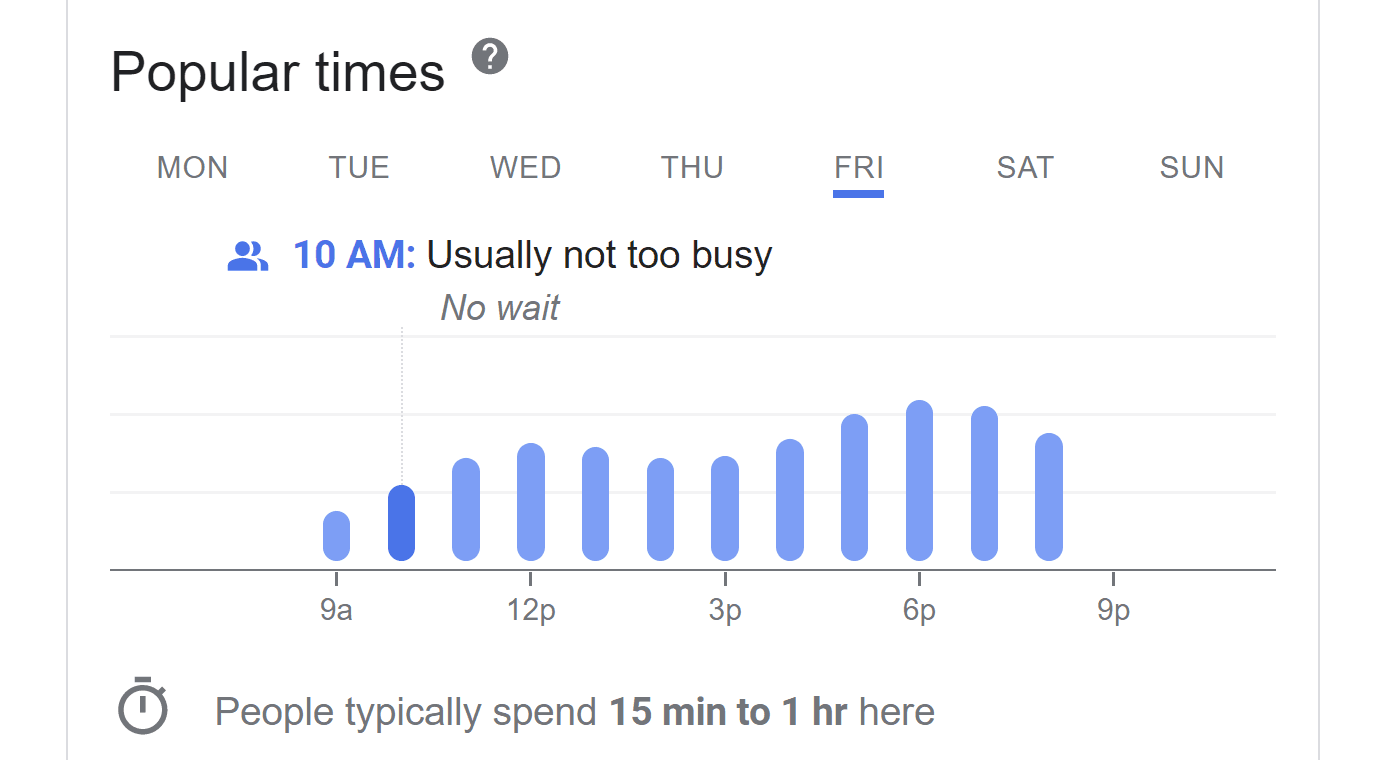
This Google Business Profile information is drawn from users who have opted into Google Location History. It’s meant to help users plan visits. It’s conceivable that this could be utilized as a ranking factor.
Controllable?
No.
Chat/Messaging
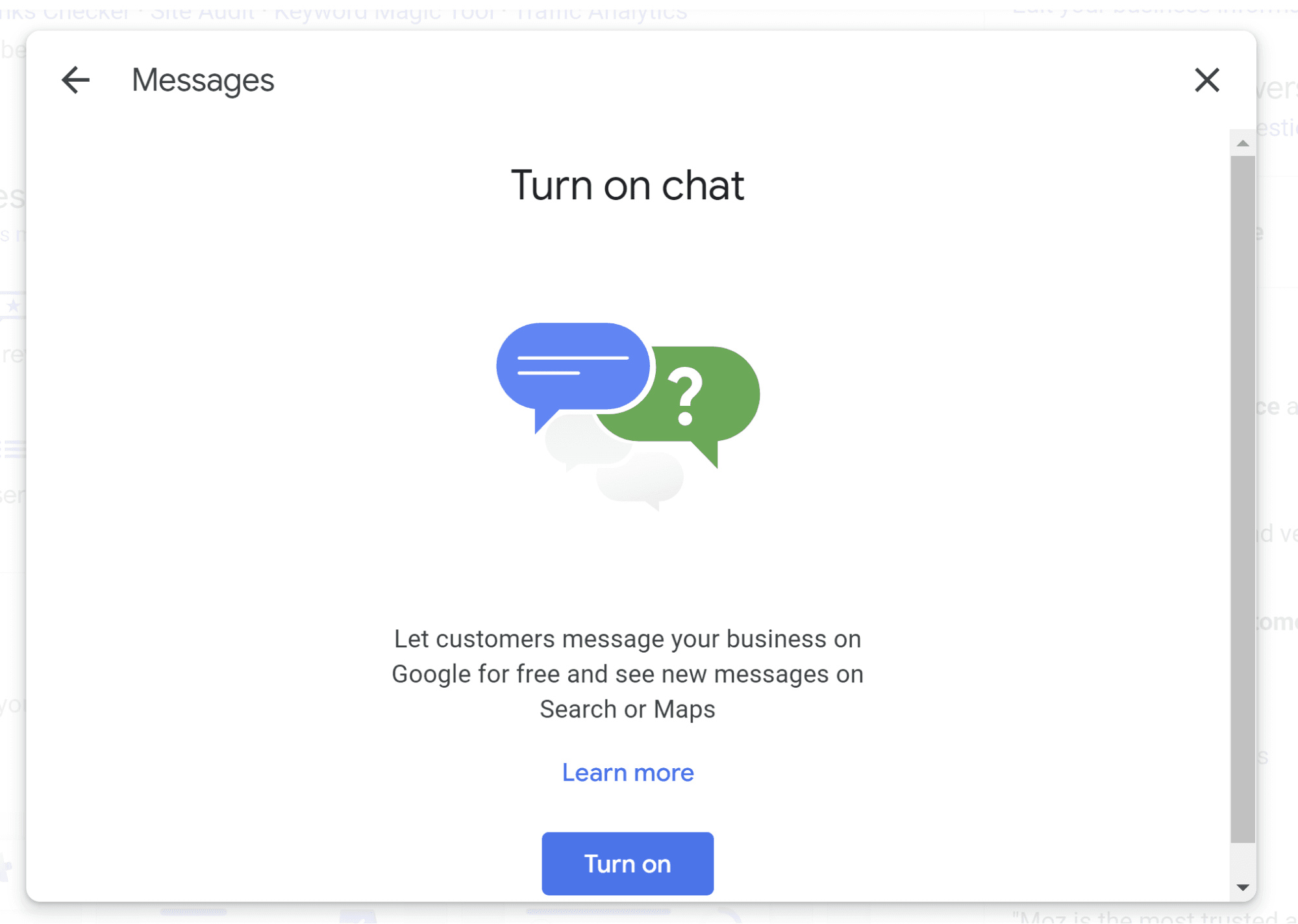
This feature enables customers to leave messages for businesses and receive responses.
Controllable? Yes — businesses can choose to opt into this.
Where to control? Google’s branding of this feature is messy. In the NMX it is labeled Messages, but when opting into the program, you will be shown a popup asking if you want to turn on “chat”, and customers will see buttons labeled “chat”. You can read more about this feature here.
Performance

The performance tab in the NMX takes you to the analytics data historically known as Insights. This is where Google reports on how the public is interacting with your listing.
Controllable? No — apart from changing the date ranges in this interface, this is not data you can edit.
Advertise

This link in the NMX takes you to where you can sign up to run paid advertising.
Controllable: Yes — local businesses can opt into Google Ads.
Admission

Some attractions feature admissions information on the Google Business Profile, with price comparisons for tickets.
Controllable? Not directly, though attractions can be sure pricing information is clear on their websites. This is a controversial feature, because Google states the following:
“Tickets are ranked based on several factors, but mainly by price. Official tickets are given preference in the ranking. Ticket suppliers don’t pay Google to appear in these search results and can’t pay to influence their ranking. Prices are based on standard adult entry and may vary depending on the specific ticket types, dates or eligibility for other discounts. Displayed currencies may differ from the currencies used to purchase tickets.”
However, as can be seen in my above example of the GBP of the Japanese Tea Garden in San Francisco, the official website of the attraction is being outranked in the Admissions results by an entity that is not official and is also more expensive, contrary to Google’s statement of how this feature should work.
Experiences
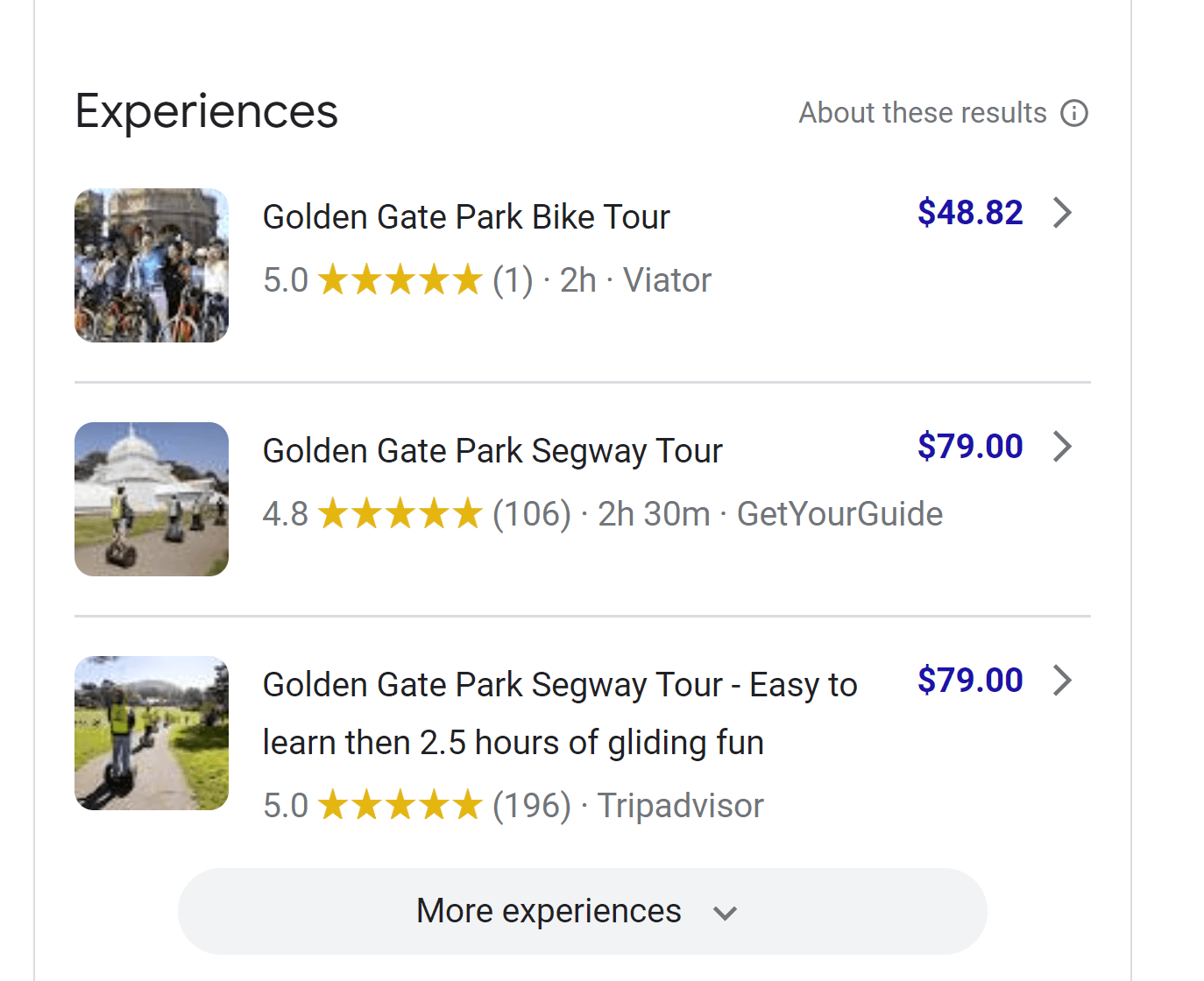
Some Google Business Profiles may included nearby experiences. This screenshot is also from the GBP of the Japanese Tea Garden in San Francisco, and is displaying other things to do in Golden Gate Park.
Controllable? No — this information is provided by Google, not the business owner.
Opening date
It has been some time since I have seen an opening date featured on a GBP, though I frequently spot them in local pack results, but businesses do have the ability to tell Google the month and year in which they were founded.
Controllable? Yes — businesses can provide this information.
Where to control?
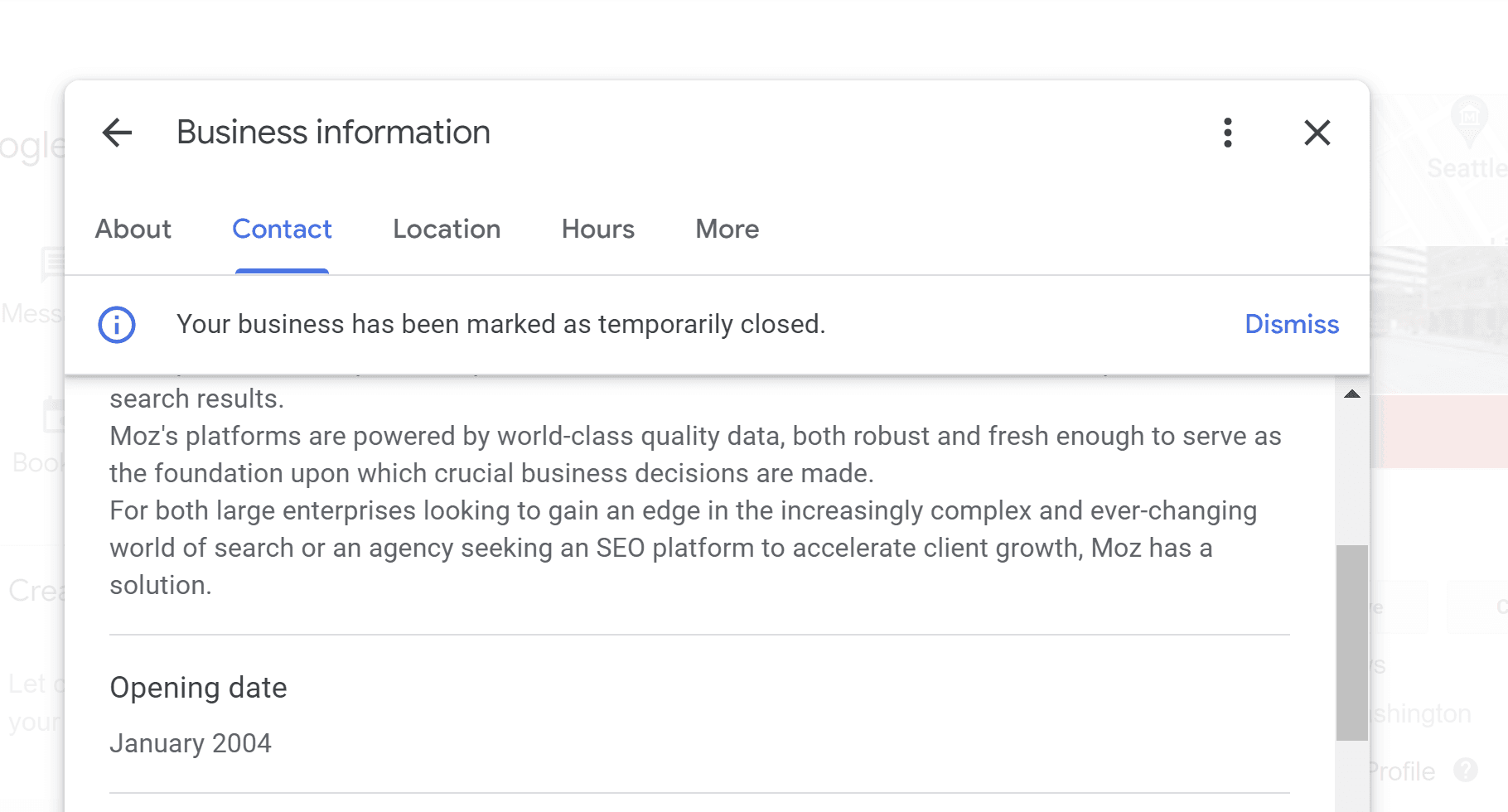
In the NMX, click on “Edit Profile” and then click on “Contact” to find the field for adding your founding date.
Lodging listings

Hotel profiles are unique to the point of being almost a different style of Google listing. They feature many distinct elements including price comparison, environmental practices, availability-based booking, and other features.
Controllable?
Mostly — owners have a variety of features they can enable and manage, though Google pulls in many elements from third parties including the public.
Where to Control? Hospitality marketers should familiarize themselves with these guidelines from Google.
Summing it up
Hopefully, this guide will act as a trusty flotation device the next time you need to manage something in your Google Business Profile via the New Merchant Experience. What I’ve learned from writing it is that if you click around long enough in the NMX, you can find most things, with a few exceptions like those that have been noted by friends like Damian Rollison and the good folks over at BrightLocal and Online Ownership.
This column has covered what the main features are and where to control them, but if you’re ready to move on to making the most of each element, read the popular Beginner’s Guide to Google Business Profiles for optimization and marketing tips. If you want to understand where GBPs fit within the larger framework of local search marketing, read The Essential Local SEO Strategy Guide for nine chapters of free, expert advice. Or, if you feel you’d benefit from investing in a more guided experience, consider registering for our video-based Local SEO Certification. Google will just keep changing – that’s a guarantee! Our best strategy, then, is to embrace continuing education. With determination and knowledge, we can all swim these laps for the win!
MARKETING
Effective Communication in Business as a Crisis Management Strategy

Everyday business life is full of challenges. These include data breaches, product recalls, market downturns and public relations conflicts that can erupt at any moment. Such situations pose a significant threat to a company’s financial health, brand image, or even its further existence. However, only 49% of businesses in the US have a crisis communications plan. It is a big mistake, as such a strategy can build trust, minimize damage, and even strengthen the company after it survives the crisis. Let’s discover how communication can transform your crisis and weather the chaos.
The ruining impact of the crisis on business
A crisis can ruin a company. Naturally, it brings losses. But the actual consequences are far worse than lost profits. It is about people behind the business – they feel the weight of uncertainty and fear. Employees start worrying about their jobs, customers might lose faith in the brand they once trusted, and investors could start looking elsewhere. It can affect the brand image and everything you build from the branding, business logo, social media can be ruined. Even after the crisis recovery, the company’s reputation can suffer, and costly efforts might be needed to rebuild trust and regain momentum. So, any sign of a coming crisis should be immediately addressed. Communication is one of the crisis management strategies that can exacerbate the situation.
The power of effective communication
Even a short-term crisis may have irreversible consequences – a damaged reputation, high employee turnover, and loss of investors. Communication becomes a tool that can efficiently navigate many crisis-caused challenges:
- Improved trust. Crisis is a synonym for uncertainty. Leaders may communicate trust within the company when the situation gets out of control. Employees feel valued when they get clear responses. The same applies to the customers – they also appreciate transparency and are more likely to continue cooperation when they understand what’s happening. In these times, documenting these moments through event photographers can visually reinforce the company’s messages and enhance trust by showing real, transparent actions.
- Reputation protection. Crises immediately spiral into gossip and PR nightmares. However, effective communication allows you to proactively address concerns and disseminate true information through the right channels. It minimizes speculation and negative media coverage.
- Saved business relationships. A crisis can cause unbelievable damage to relationships with employees, customers, and investors. Transparent communication shows the company’s efforts to find solutions and keeps stakeholders informed and engaged, preventing misunderstandings and painful outcomes.
- Faster recovery. With the help of communication, the company is more likely to receive support and cooperation. This collaborative approach allows you to focus on solutions and resume normal operations as quickly as possible.
It is impossible to predict when a crisis will come. So, a crisis management strategy mitigates potential problems long before they arise.
Tips on crafting an effective crisis communication plan.
To effectively deal with unforeseen critical situations in business, you must have a clear-cut communication action plan. This involves things like messages, FAQs, media posts, and awareness of everyone in the company. This approach saves precious time when the crisis actually hits. It allows you to focus on solving the problem instead of intensifying uncertainty and panic. Here is a step-by-step guide.
Identify your crisis scenarios.
Being caught off guard is the worst thing. So, do not let it happen. Conduct a risk assessment to pinpoint potential crises specific to your business niche. Consider both internal and external factors that could disrupt normal operations or damage the online reputation of your company. Study industry-specific issues, past incidents, and current trends. How will you communicate in each situation? Knowing your risks helps you prepare targeted communication strategies in advance. Of course, it is impossible to create a perfectly polished strategy, but at least you will build a strong foundation for it.
Form a crisis response team.
The next step is assembling a core team. It will manage communication during a crisis and should include top executives like the CEO, CFO, and CMO, and representatives from key departments like public relations and marketing. Select a confident spokesperson who will be the face of your company during the crisis. Define roles and responsibilities for each team member and establish communication channels they will work with, such as email, telephone, and live chat. Remember, everyone in your crisis response team must be media-savvy and know how to deliver difficult messages to the stakeholders.
Prepare communication templates.
When a crisis hits, things happen fast. That means communication needs to be quick, too. That’s why it is wise to have ready-to-go messages prepared for different types of crises your company may face. These messages can be adjusted to a particular situation when needed and shared on the company’s social media, website, and other platforms right away. These templates should include frequently asked questions and outline the company’s general responses. Make sure to approve these messages with your legal team for accuracy and compliance.
Establish communication protocols.
A crisis is always chaotic, so clear communication protocols are a must-have. Define trigger points – specific events that would launch the crisis communication plan. Establish a clear hierarchy for messages to avoid conflicting information. Determine the most suitable forms and channels, like press releases or social media, to reach different audiences. Here is an example of how you can structure a communication protocol:
- Immediate alert. A company crisis response team is notified about a problem.
- Internal briefing. The crisis team discusses the situation and decides on the next steps.
- External communication. A spokesperson reaches the media, customers, and suppliers.
- Social media updates. A trained social media team outlines the situation to the company audience and monitors these channels for misinformation or negative comments.
- Stakeholder notification. The crisis team reaches out to customers and partners to inform them of the incident and its risks. They also provide details on the company’s response efforts and measures.
- Ongoing updates. Regular updates guarantee transparency and trust and let stakeholders see the crisis development and its recovery.
Practice and improve.
Do not wait for the real crisis to test your plan. Conduct regular crisis communication drills to allow your team to use theoretical protocols in practice. Simulate different crisis scenarios and see how your people respond to these. It will immediately demonstrate the strong and weak points of your strategy. Remember, your crisis communication plan is not a static document. New technologies and evolving media platforms necessitate regular adjustments. So, you must continuously review and update it to reflect changes in your business and industry.
Wrapping up
The ability to handle communication well during tough times gives companies a chance to really connect with the people who matter most—stakeholders. And that connection is a foundation for long-term success. Trust is key, and it grows when companies speak honestly, openly, and clearly. When customers and investors trust the company, they are more likely to stay with it and even support it. So, when a crisis hits, smart communication not only helps overcome it but also allows you to do it with minimal losses to your reputation and profits.
MARKETING
Should Your Brand Shout Its AI and Marketing Plan to the World?

To use AI or not to use AI, that is the question.
Let’s hope things work out better for you than they did for Shakespeare’s mad Danish prince with daddy issues.
But let’s add a twist to that existential question.
CMI’s chief strategy officer, Robert Rose, shares what marketers should really contemplate. Watch the video or read on to discover what he says:
Should you not use AI and be proud of not using it? Dove Beauty did that last week.
Should you use it but keep it a secret? Sports Illustrated did that last year.
Should you use AI and be vocal about using it? Agency giant Brandtech Group picked up the all-in vibe.
Should you not use it but tell everybody you are? The new term “AI washing” is hitting everywhere.
What’s the best option? Let’s explore.
Dove tells all it won’t use AI
Last week, Dove, the beauty brand celebrating 20 years of its Campaign for Real Beauty, pledged it would NEVER use AI in visual communication to portray real people.
In the announcement, they said they will create “Real Beauty Prompt Guidelines” that people can use to create images representing all types of physical beauty through popular generative AI programs. The prompt they picked for the launch video? “The most beautiful woman in the world, according to Dove.”
I applaud them for the powerful ad. But I’m perplexed by Dove issuing a statement saying it won’t use AI for images of real beauty and then sharing a branded prompt for doing exactly that. Isn’t it like me saying, “Don’t think of a parrot eating pizza. Don’t think about a parrot eating pizza,” and you can’t help but think about a parrot eating pizza right now?
Brandtech Group says it’s all in on AI
Now, Brandtech Group, a conglomerate ad agency, is going the other way. It’s going all-in on AI and telling everybody.
This week, Ad Age featured a press release — oops, I mean an article (subscription required) — with the details of how Brandtech is leaning into the takeaway from OpenAI’s Sam Altman, who says 95% of marketing work today can be done by AI.
A Brandtech representative talked about how they pitch big brands with two people instead of 20. They boast about how proud they are that its lean 7,000 staffers compete with 100,000-person teams. (To be clear, showing up to a pitch with 20 people has never been a good thing, but I digress.)
OK, that’s a differentiated approach. They’re all in. Ad Age certainly seemed to like it enough to promote it. Oops, I mean report about it.
False claims of using AI and not using AI
Offshoots of the all-in and never-will approaches also exist.
The term “AI washing” is de rigueur to describe companies claiming to use AI for something that really isn’t AI. The US Securities and Exchange Commission just fined two companies for using misleading statements about their use of AI in their business model. I know one startup technology organization faced so much pressure from their board and investors to “do something with AI” that they put a simple chatbot on their website — a glorified search engine — while they figured out what they wanted to do.
Lastly and perhaps most interestingly, companies have and will use AI for much of what they create but remain quiet about it or desire to keep it a secret. A recent notable example is the deepfake ad of a woman in a car professing the need for people to use a particular body wipe to get rid of body odor. It was purported to be real, but sharp-eyed viewers suspected the fake and called out the company, which then admitted it. Or was that the brand’s intent all along — the AI-use outrage would bring more attention?
This is an AI generated influencer video.
Looks 100% real. Even the interior car detailing.
UGC content for your brand is about to get really cheap. ☠️ pic.twitter.com/2m10RqoOW3
— Jon Elder | Amazon Growth | Private Label (@BlackLabelAdvsr) March 26, 2024
To yell or not to yell about your brand’s AI decision
Should a brand yell from a mountaintop that they use AI to differentiate themselves a la Brandtech? Or should a brand yell they’re never going to use AI to differentiate themselves a la Dove? Or should a brand use it and not yell anything? (I think it’s clear that a brand should not use AI and lie and say it is. That’s the worst of all choices.)
I lean far into not-yelling-from-mountaintop camp.
When I see a CEO proudly exclaim that they laid off 90% of their support workforce because of AI, I’m not surprised a little later when the value of their service is reduced, and the business is failing.
I’m not surprised when I hear “AI made us do it” to rationalize the latest big tech company latest rounds of layoffs. Or when a big consulting firm announces it’s going all-in on using AI to replace its creative and strategic resources.
I see all those things as desperate attempts for short-term attention or a distraction from the real challenge. They may get responses like, “Of course, you had to lay all those people off; AI is so disruptive,” or “Amazing. You’re so out in front of the rest of the pack by leveraging AI to create efficiency, let me cover your story.” Perhaps they get this response, “Your company deserves a bump in stock price because you’re already using this fancy new technology.”
But what happens if the AI doesn’t deliver as promoted? What happens the next time you need to lay off people? What happens the next time you need to prove your technologically forward-leaning?
Yelling out that you’re all in on a disruptive innovation, especially one the public doesn’t yet trust a lot is (at best) a business sugar high. That short-term burst of attention may or may not foul your long-term brand value.
Interestingly, the same scenarios can manifest when your brand proclaims loudly it is all out of AI, as Dove did. The sugar high may not last and now Dove has itself into a messaging box. One slip could cause distrust among its customers. And what if AI gets good at demonstrating diversity in beauty?
I tried Dove’s instructions and prompted ChatGPT for a picture of “the most beautiful woman in the world according to the Dove Real Beauty ad.”
It gave me this. Then this. And this. And finally, this.
She’s absolutely beautiful, but she doesn’t capture the many facets of diversity Dove has demonstrated in its Real Beauty campaigns. To be clear, Dove doesn’t have any control over generating the image. Maybe the prompt worked well for Dove, but it didn’t for me. Neither Dove nor you can know how the AI tool will behave.
To use AI or not to use AI?
When brands grab a microphone to answer that question, they work from an existential fear about the disruption’s meaning. They do not exhibit the confidence in their actions to deal with it.
Let’s return to Hamlet’s soliloquy:
Thus conscience doth make cowards of us all;
And thus the native hue of resolution
Is sicklied o’er with the pale cast of thought,
And enterprises of great pith and moment
With this regard their currents turn awry
And lose the name of action.
In other words, Hamlet says everybody is afraid to take real action because they fear the unknown outcome. You could act to mitigate or solve some challenges, but you don’t because you don’t trust yourself.
If I’m a brand marketer for any business (and I am), I’m going to take action on AI for my business. But until I see how I’m going to generate value with AI, I’m going to be circumspect about yelling or proselytizing how my business’ future is better.
HANDPICKED RELATED CONTENT:
Cover image by Joseph Kalinowski/Content Marketing Institute
MARKETING
How to Use AI For a More Effective Social Media Strategy, According to Ross Simmonds

Welcome to Creator Columns, where we bring expert HubSpot Creator voices to the Blogs that inspire and help you grow better.
It’s the age of AI, and our job as marketers is to keep up.
My team at Foundation Marketing recently conducted an AI Marketing study surveying hundreds of marketers, and more than 84% of all leaders, managers, SEO experts, and specialists confirmed that they used AI in the workplace.

If you can overlook the fear-inducing headlines, this technology is making social media marketers more efficient and effective than ever. Translation: AI is good news for social media marketers.
In fact, I predict that the marketers not using AI in their workplace will be using it before the end of this year, and that number will move closer and closer to 100%.
Social media and AI are two of the most revolutionizing technologies of the last few decades. Social media has changed the way we live, and AI is changing the way we work.
So, I’m going to condense and share the data, research, tools, and strategies that the Foundation Marketing Team and I have been working on over the last year to help you better wield the collective power of AI and social media.
Let’s jump into it.
What’s the role of AI in social marketing strategy?
In a recent episode of my podcast, Create Like The Greats, we dove into some fascinating findings about the impact of AI on marketers and social media professionals. Take a listen here:
Let’s dive a bit deeper into the benefits of this technology:
Benefits of AI in Social Media Strategy
AI is to social media what a conductor is to an orchestra — it brings everything together with precision and purpose. The applications of AI in a social media strategy are vast, but the virtuosos are few who can wield its potential to its fullest.
AI to Conduct Customer Research
Imagine you’re a modern-day Indiana Jones, not dodging boulders or battling snakes, but rather navigating the vast, wild terrain of consumer preferences, trends, and feedback.
This is where AI thrives.
Using social media data, from posts on X to comments and shares, AI can take this information and turn it into insights surrounding your business and industry. Let’s say for example you’re a business that has 2,000 customer reviews on Google, Yelp, or a software review site like Capterra.
Leveraging AI you can now have all 2,000 of these customer reviews analyzed and summarized into an insightful report in a matter of minutes. You simply need to download all of them into a doc and then upload them to your favorite Generative Pre-trained Transformer (GPT) to get the insights and data you need.
But that’s not all.
You can become a Prompt Engineer and write ChatGPT asking it to help you better understand your audience. For example, if you’re trying to come up with a persona for people who enjoy marathons but also love kombucha you could write a prompt like this to ChatGPT:

The response that ChatGPT provided back is quite good:

Below this it went even deeper by including a lot of valuable customer research data:
- Demographics
- Psychographics
- Consumer behaviors
- Needs and preferences
And best of all…
It also included marketing recommendations.
The power of AI is unbelievable.
Social Media Content Using AI
AI’s helping hand can be unburdening for the creative spirit.
Instead of marketers having to come up with new copy every single month for posts, AI Social Caption generators are making it easier than ever to craft catchy status updates in the matter of seconds.
Tools like HubSpot make it as easy as clicking a button and telling the AI tool what you’re looking to create a post about:

The best part of these AI tools is that they’re not limited to one channel.
Your AI social media content assistant can help you with LinkedIn content, X content, Facebook content, and even the captions that support your post on Instagram.
It can also help you navigate hashtags:

With AI social media tools that generate content ideas or even write posts, it’s not about robots replacing humans. It’s about making sure that the human creators on your team are focused on what really matters — adding that irreplaceable human touch.
Enhanced Personalization
You know that feeling when a brand gets you, like, really gets you?
AI makes that possible through targeted content that’s tailored with a level of personalization you’d think was fortune-telling if the data didn’t paint a starker, more rational picture.
What do I mean?
Brands can engage more quickly with AI than ever before. In the early 2000s, a lot of brands spent millions of dollars to create social media listening rooms where they would hire social media managers to find and engage with any conversation happening online.
Thanks to AI, brands now have the ability to do this at scale with much fewer people all while still delivering quality engagement with the recipient.
Analytics and Insights
Tapping into AI to dissect the data gives you a CSI-like precision to figure out what works, what doesn’t, and what makes your audience tick. It’s the difference between guessing and knowing.
The best part about AI is that it can give you almost any expert at your fingertips.
If you run a report surrounding the results of your social media content strategy directly from a site like LinkedIn, AI can review the top posts you’ve shared and give you clear feedback on what type of content is performing, why you should create more of it, and what days of the week your content is performing best.
This type of insight that would typically take hours to understand.
Now …
Thanks to the power of AI you can upload a spreadsheet filled with rows and columns of data just to be met with a handful of valuable insights a few minutes later.
Improved Customer Service
Want 24/7 support for your customers?
It’s now possible without human touch.
Chatbots powered by AI are taking the lead on direct messaging experiences for brands on Facebook and other Meta properties to offer round-the-clock assistance.
The fact that AI can be trained on past customer queries and data to inform future queries and problems is a powerful development for social media managers.
Advertising on Social Media with AI
The majority of ad networks have used some variation of AI to manage their bidding system for years. Now, thanks to AI and its ability to be incorporated in more tools, brands are now able to use AI to create better and more interesting ad campaigns than ever before.
Brands can use AI to create images using tools like Midjourney and DALL-E in seconds.
Brands can use AI to create better copy for their social media ads.
Brands can use AI tools to support their bidding strategies.
The power of AI and social media is continuing to evolve daily and it’s not exclusively found in the organic side of the coin. Paid media on social media is being shaken up due to AI just the same.
How to Implement AI into Your Social Media Strategy
Ready to hit “Go” on your AI-powered social media revolution?
Don’t just start the engine and hope for the best. Remember the importance of building a strategy first. In this video, you can learn some of the most important factors ranging from (but not limited to) SMART goals and leveraging influencers in your day-to-day work:
The following seven steps are crucial to building a social media strategy:
- Identify Your AI and Social Media Goals
- Validate Your AI-Related Assumptions
- Conduct Persona and Audience Research
- Select the Right Social Channels
- Identify Key Metrics and KPIs
- Choose the Right AI Tools
- Evaluate and Refine Your Social Media and AI Strategy
Keep reading, roll up your sleeves, and follow this roadmap:
1. Identify Your AI and Social Media Goals
If you’re just dipping your toes into the AI sea, start by defining clear objectives.
Is it to boost engagement? Streamline your content creation? Or simply understand your audience better? It’s important that you spend time understanding what you want to achieve.
For example, say you’re a content marketing agency like Foundation and you’re trying to increase your presence on LinkedIn. The specificity of this goal will help you understand the initiatives you want to achieve and determine which AI tools could help you make that happen.
Are there AI tools that will help you create content more efficiently? Are there AI tools that will help you optimize LinkedIn Ads? Are there AI tools that can help with content repurposing? All of these things are possible and having a goal clearly identified will help maximize the impact. Learn more in this Foundation Marketing piece on incorporating AI into your content workflow.
Once you have identified your goals, it’s time to get your team on board and assess what tools are available in the market.
Recommended Resources:
2. Validate Your AI-Related Assumptions
Assumptions are dangerous — especially when it comes to implementing new tech.
Don’t assume AI is going to fix all your problems.
Instead, start with small experiments and track their progress carefully.
3. Conduct Persona and Audience Research
Social media isn’t something that you can just jump into.
You need to understand your audience and ideal customers. AI can help with this, but you’ll need to be familiar with best practices. If you need a primer, this will help:
Once you understand the basics, consider ways in which AI can augment your approach.
4. Select the Right Social Channels
Not every social media channel is the same.
It’s important that you understand what channel is right for you and embrace it.
The way you use AI for X is going to be different from the way you use AI for LinkedIn. On X, you might use AI to help you develop a long-form thread that is filled with facts and figures. On LinkedIn however, you might use AI to repurpose a blog post and turn it into a carousel PDF. The content that works on X and that AI can facilitate creating is different from the content that you can create and use on LinkedIn.
The audiences are different.
The content formats are different.
So operate and create a plan accordingly.
Recommended Tools and Resources:
5. Identify Key Metrics and KPIs
What metrics are you trying to influence the most?
Spend time understanding the social media metrics that matter to your business and make sure that they’re prioritized as you think about the ways in which you use AI.
These are a few that matter most:
- Reach: Post reach signifies the count of unique users who viewed your post. How much of your content truly makes its way to users’ feeds?
- Clicks: This refers to the number of clicks on your content or account. Monitoring clicks per campaign is crucial for grasping what sparks curiosity or motivates people to make a purchase.
- Engagement: The total social interactions divided by the number of impressions. This metric reveals how effectively your audience perceives you and their readiness to engage.
Of course, it’s going to depend greatly on your business.
But with this information, you can ensure that your AI social media strategy is rooted in goals.
6. Choose the Right AI Tools
The AI landscape is filled with trash and treasure.
Pick AI tools that are most likely to align with your needs and your level of tech-savviness.
For example, if you’re a blogger creating content about pizza recipes, you can use HubSpot’s AI social caption generator to write the message on your behalf:

The benefit of an AI tool like HubSpot and the caption generator is that what at one point took 30-40 minutes to come up with — you can now have it at your fingertips in seconds. The HubSpot AI caption generator is trained on tons of data around social media content and makes it easy for you to get inspiration or final drafts on what can be used to create great content.
Consider your budget, the learning curve, and what kind of support the tool offers.
7. Evaluate and Refine Your Social Media and AI Strategy
AI isn’t a magic wand; it’s a set of complex tools and technology.
You need to be willing to pivot as things come to fruition.
If you notice that a certain activity is falling flat, consider how AI can support that process.
Did you notice that your engagement isn’t where you want it to be? Consider using an AI tool to assist with crafting more engaging social media posts.
Make AI Work for You — Now and in the Future
AI has the power to revolutionize your social media strategy in ways you may have never thought possible. With its ability to conduct customer research, create personalized content, and so much more, thinking about the future of social media is fascinating.
We’re going through one of the most interesting times in history.
Stay equipped to ride the way of AI and ensure that you’re embracing the best practices outlined in this piece to get the most out of the technology.
-

 PPC6 days ago
PPC6 days ago19 Best SEO Tools in 2024 (For Every Use Case)
-
SEARCHENGINES7 days ago
Daily Search Forum Recap: April 17, 2024
-
SEARCHENGINES6 days ago
Daily Search Forum Recap: April 18, 2024
-
SEARCHENGINES5 days ago
Daily Search Forum Recap: April 19, 2024
-

 MARKETING6 days ago
MARKETING6 days agoEcommerce evolution: Blurring the lines between B2B and B2C
-

 WORDPRESS5 days ago
WORDPRESS5 days agoHow to Make $5000 of Passive Income Every Month in WordPress
-

 SEO6 days ago
SEO6 days ago2024 WordPress Vulnerability Report Shows Errors Sites Keep Making
-

 WORDPRESS6 days ago
WORDPRESS6 days ago10 Amazing WordPress Design Resouces – WordPress.com News














![How to Use AI For a More Effective Social Media Strategy, According to Ross Simmonds Download Now: The 2024 State of Social Media Trends [Free Report]](https://articles.entireweb.com/wp-content/uploads/2024/04/How-to-Use-AI-For-a-More-Effective-Social-Media.png)


You must be logged in to post a comment Login